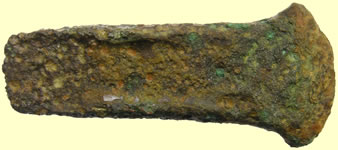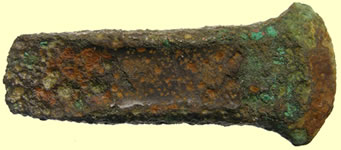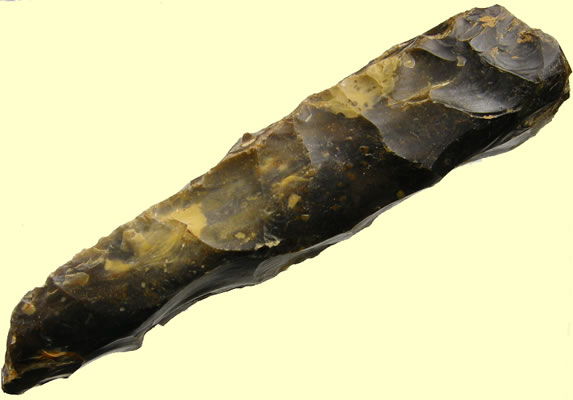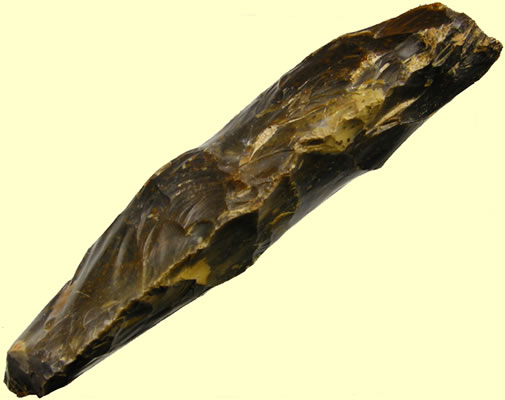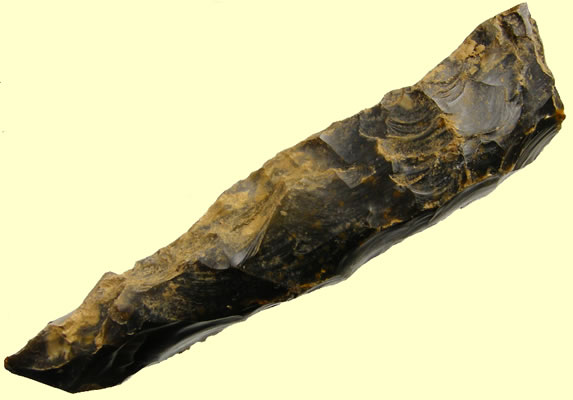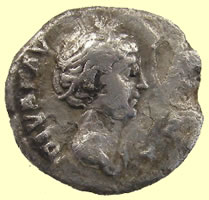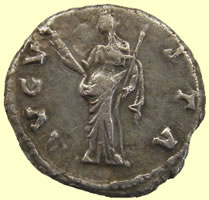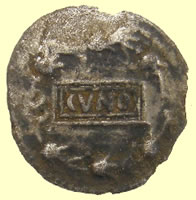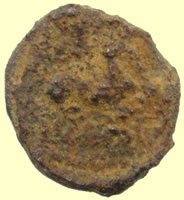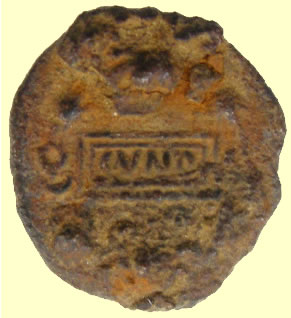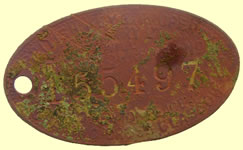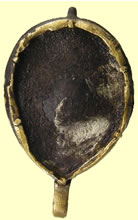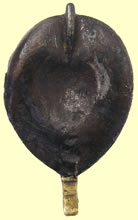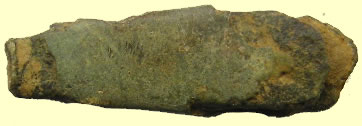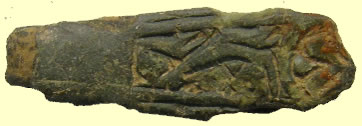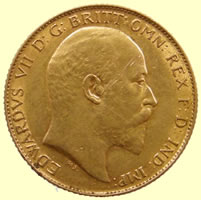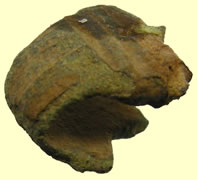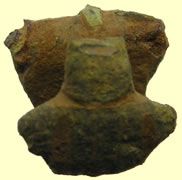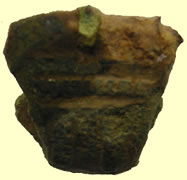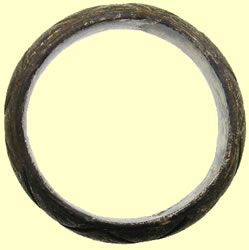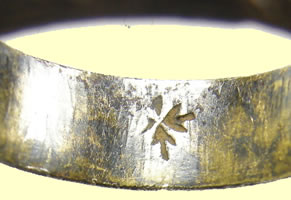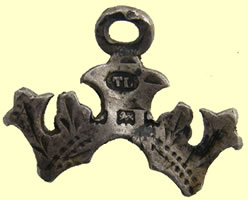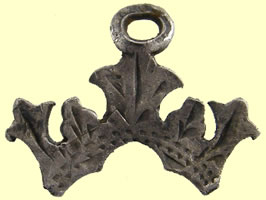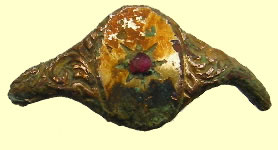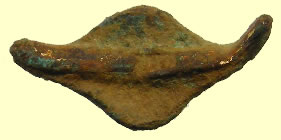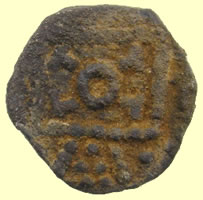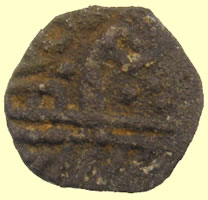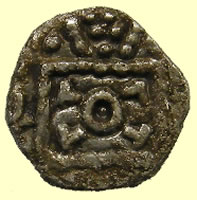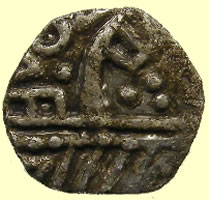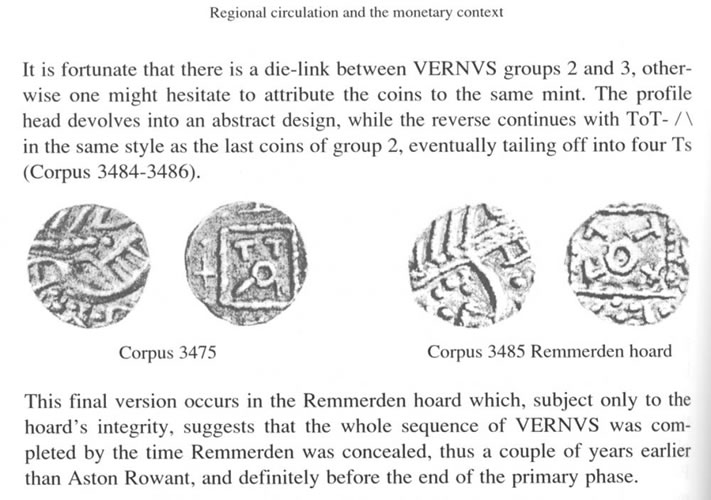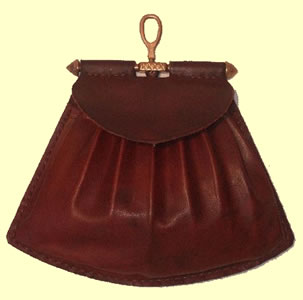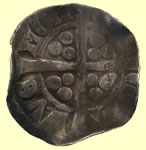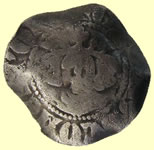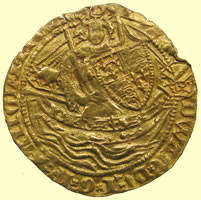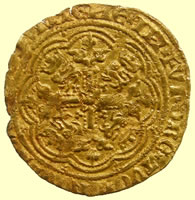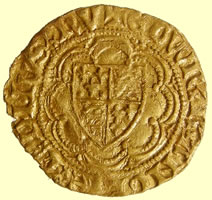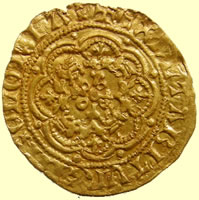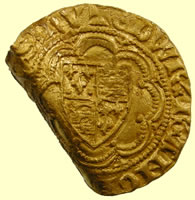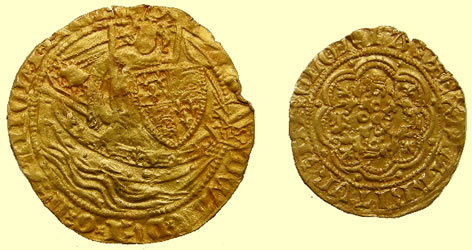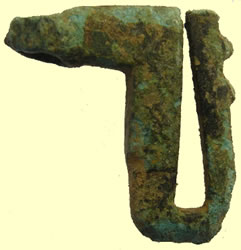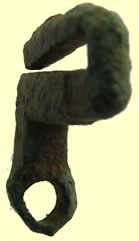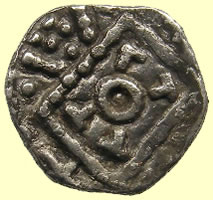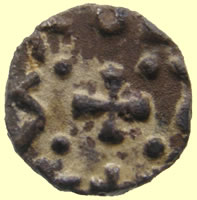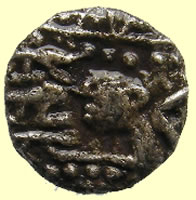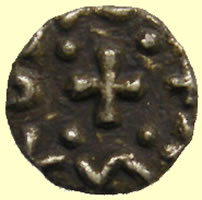

Metal detecting holidays in England with the World's most successful metal detecting club.
Twinned with Midwest Historical Research Society USA
| 2013 April finds page |
70BC Morini boat tree Celtic gold qtr stater Reported as potential hoard to museum 1.51g,10.18mm CCI 13.0074 |
|||
Medieval barrel spigot with cockerel type tap - similar recorded on PAS below (c. AD 1400-1600). The key (or handle) is a two-dimensional representation of a cockerel, with a large ring and dot eye, open beak, small crest and curved tail being the only detail applied Record ID: BERK-A3B3B5 Record ID: SOM-901263 |
|||
 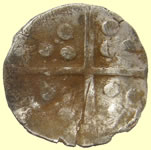 |
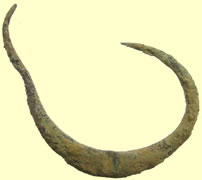 |
||
1476 Edward IV hammered silver penny - Type Dudley local - Durham IM Cinquefoil Bishop William Dudley 1476-1483 DV by bust - No D at centre of reverse cross is rare Obv EDWARD + DI + GRA REX ANGL
|
Medieval buckle | ||
Cooking 2ndC Roman silver coin - the obv shows how thick the crust cooking off is
Cooking 2ndC Roman silver coin - another example of how thick the crust cooking off is |
|||
As dug and cooking pictures Penn Dennis' crispy Roman silver is start to 'cook' up after being in the pot since March 2012 !! Still more crust to remove yet but I sent it off for ID. the obverse legend is DIVA FAVSTINA ("the deified" Faustina) and portrays her in the usual way with a fairly elaborate hairstyle, somewhat swept up in the back with a small bun at the top of the head. Faustina Sr.for him - a posthumous piece (as is the majority of her coinage) for the wifeof Antoninus Pius. She died in 141, only 3 years into Antoninus' longreign, and had significant posthumous coinages struck in her honor, first byAntoninus Pius, then later by Marcus Aurelius - her son-in-law. Mark |
|||
Crispy Roman silver is start to 'cook' up after being in the cooker since March 2012 |
|||
As dug and 'Cooking' Roman silver - still more to do yet and then I will resent it to Mark Lehman The details are still a bit fuzzy, but I can tell you that it's a denarius of Hadrian (117-138 AD.) and the reverse type is TELLVS STABIL. A woman - the personification of Tellus - standing left holding a plow-handle and a rake - 2 corn plants protrude from the ground behind her. This is a product of the Mint at Rome in 133 AD. The obverse reads (or should read) HADRIANVS AVG COS III P P - and if you study it closely, you can tell that it does have that legend. |
|||
As dug and 'cooking' pics - still more work to do yet Primary Saxon silver sceat 600- 700 AD - sent to Fitzwilliam museum for recording and ID |
|||
  |
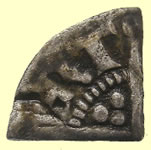 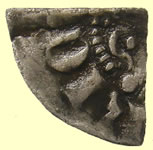 |
||
| 1918 George V milled silver floin (24 pence) | 1247 Henry III hammered silver voided long cross farthing | ||
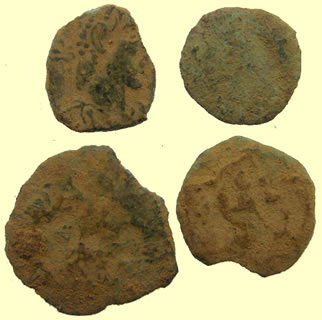 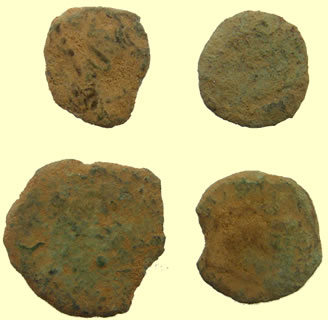 |
|||
Four more 5thC Roman bronze coins reported to museum as hoard - when you find a 'hoard' the coins must be handed in 'as dug' condition In the photo of the group of 4 pieces, the one on the upper left is the only one I'm reasonably certain about. It's Constantius II (most likely, although without any visible legend there is a very small chance it might be Constans) and it's one of the ubiquitous FEL TEMP REPARATIO pieces depicting a soldier advancing to the left and spearing an unfortunately unhorsed foe Mark |
|||
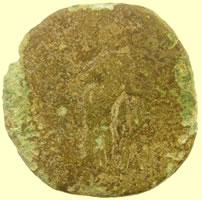 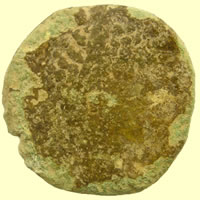 |
|||
Rough 2ndC large Roman bronze - unusual pointy chin on the bust so I have sent it off to Mark Lehman to see if he can ID it Marcus Aurelius, 139-161 (Caesar) and 161-180 (Augustus) - although this dupondius is somewhat obscured by the rough surfaces and the rays of his crown are hiding the rows of curls in his hair to a certain extent, this is an example from soon after his elevation to Augustus with a particularly pointy-chinned portrait: Mark |
|||
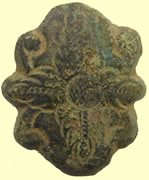 |
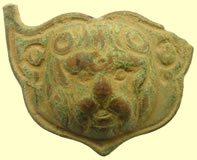 |
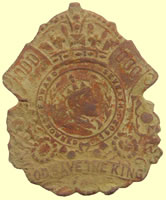 |
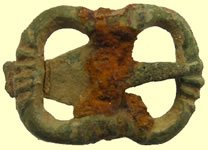 |
| 1500-1700 mount | Georgian mount | Edward VII coronation medallion | Cast copper alloy trapezoidal shoe or knee buckle with concave sides 1660-1720 |
 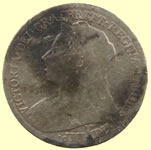 |
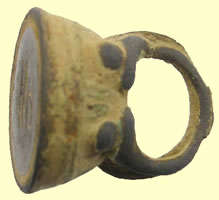  |
||
| 1895 Victoria milled silver sixpence | Georgian fob seal | ||
 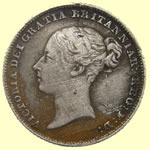 |
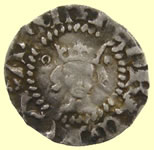  |
||
| 1846 Victoria milled silver sixpence | 1413- 22 Henry V hammered silver farthing - Type 7 - early hair type Broken annulet right and pellet left either side of crown Obv + HENRICxREXxANGL Rev CIV/TAS/LON/DON- London mint |
||
 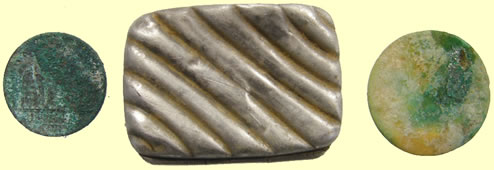 |
|||
| What great find 1873 Birmingham solid silver pill box with 2 - 1870 continental coins inside | |||
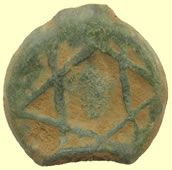 |
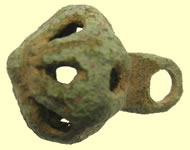 |
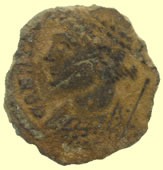 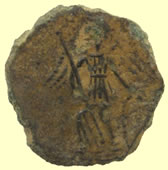 |
|
| Medieval copper bale seal | 16thC Tudor fretwork button | Another 4thC hoard coin sent for ID and reported to museum "CONSTANTINOPOLIS" - One the so-called "City Commemorative" Centenionales issued in the names of Rome and Constantinople dating to the time of Constantine I moving to the newly-fortified Constantinople as his capital - c. 330-337- these are contemporary with the very common "GLORIA EXERCITVS types with two soldiers standing flanking either two or one legionary standard. The obverse is an allegorical personification of Constantinople as a helmeted and mantled female with a spear held over her shoulder. The reverse is anepigraphic (except for exergual mint marks) and shows Victory standing left in the prow of a galley holding a spear and resting on a shield. The mint mark is off-flan on this specimen, although the style is European - as opposed to the style at the Asian mints. http://www.stoa.org/gallery/album165/58_Cpls_TRE_b Mark |
|
This is a fascinating example of a worn die 70BC Morini Celtic gold qtr stater or is it another very rare North Thames type based on Gallo-Belgic D Boat Tree quarters Reported as potential hoard to museum and sent to CCI for recording
1.45g 10.83mm The Boat Tree quarter with Y reverse is a scarce early variant of the normal Gallic War type, probably dating from the early 50s BC; it isn't in ABC but should probably be listed as a separate type in a future edition. John CCI 13.0075 |
|||
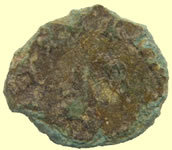 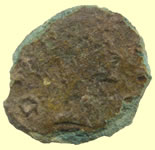 |
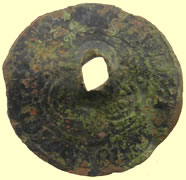 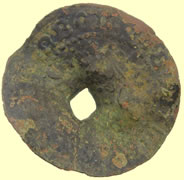 |
||
4thC Roman bronze coin sent for ID "DIVO CLAVDIO" - Posthumous commemorative antoninianus for Claudius Gothicus struck c. 270 by his brother Quintillus and/or Aurelian at the beginning of his reign. Also this type is one of the most widely copied prototypes in the manufacture of so-called "Barbarous Radiates", the contemporary copies produced as emergency currency during times when there was no regular re-supply of regal coin from Rome - ie: during the later Gallic Empire, during the revolt of Carausius/Allectus, and as the Romans finally withdrew their administration first from Britain, then from Gaul in the 5th century. I'm not certain what the reverse type is on this one, although the legend will almost invariably be the same on all of these - CONSECRATIO - The most common types are an eagle standing, facing, head either to right or left (which is probably the most likely type for this piece to be - see below) or the paneled facade of an altar with flames and horns showing above. |
1586 Hans Krauwincel II Rose orb Jetton HANNS KRAVWINCKEL IN NVRENB |
||
 |
 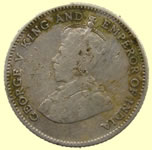 |
||
| Bush tractor plate | 1926 George V milled silver India 10 cents | ||
 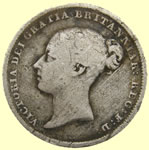 |
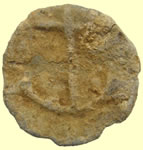 |
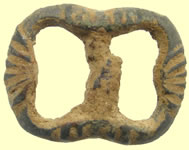 |
|
| 1844 Victoria milled silver sixpence | 17thC lead trade token | Cast copper alloy trapezoidal shoe or knee buckle with concave sides 1660-1720 |
|
  |
 |
 |
|
1272 Edward 1st hammered silver penny Obv EDWAR R ANGL ***** Rev CIV/TAS/LON/DON- London mint |
15thC lead token - type 2 | Britannia badge | |
Addedomarus 45BC Celtic gold full stater - sent to CCI for recording & reported as potential hoard to museum 17.54mm,5.50g CCI 13.0076. |
|||
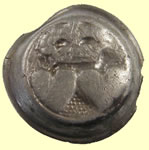 |
|
||
| 17thC Charles II silver button reported to museum as treasure | Huge silver 'Hunter' sized pocket fob watch dated 1879 London mint - maker JJ |
||
 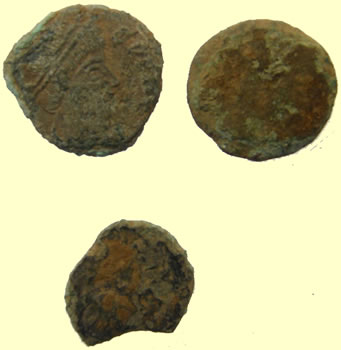 |
|||
Another 3 Roman 4thC coins from the existing hoard area - report to museum as hoard - sent to Mark Lehman for his views There's really not a lot for me to work with here. The only one I could comment upon with any confidence is the one with the fairly clear portrait. If I'm reading the surviving letters of the legend correctly, it would make this likely to be either Constans or Valens - each commonly breaks their obverse legend before the terminal "S " in their name - like this: (VALEN - S or CONSTAN - S) "... - S P F AVG". If it's Constans, chances are it's either a single-standard Gloria Exercitvs or a fallen horseman Fel Temp. If it's Valens, it's about a 50-50 chance of being a GLORIA ROMANORVM with emperor dragging captive and carrying a labarum or SECVRITAS REIPVBLICAE with Victory walking left carrying wreath and palm. The piece which is most round - upper right - seems to show evidence of a small circle on the reverse which might be a wreath held by one of two Victories facing each other holding wreaths on a VICTORIAE DD AVGG Q NN - (rotate it 45º counter-clockwise, the Victory is on the left holding the wreath out at chest level) These were the final incarnation of the Centenionalis before it was scrapped in 348 and the FEL TEMP - Majorina-based coinage was introduced. Those were struck only by Constans and by Constantius II, but are otherwise identical except for the names in the obverse legends. These were struck only in the years 347-348 so if that's what it turns out to be, it's closely datable despite perhaps not being attributable to any specific ruler. The one with a bite taken out of it really has no distinguishing features clear enough to make any sort of firm guess, but in rotating the reverse, I think I might have seen it as a FEL TEMP fallen horseman type. - However, since that is the most common single type of coin surviving from antiquity, it's always a pretty safe guess when there are no clear features from which to ID it as something else. Mark |
|||
 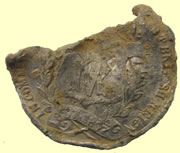 |
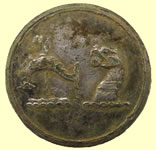 |
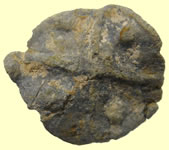 |
|
| 1897 Victoria diamond jubilee medallion | 19thC livery button | 15thC lead token | |
Stunning condition 1778 Russian lead bale seal N.P is Unprovenanced
|
1770 Russian lead bale seal W.K. is Unprovenanced |
||
Huge 17thC working toy petronel (pistol) |
|||
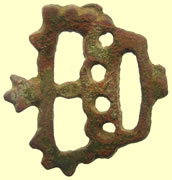 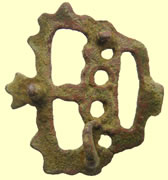 |
 |
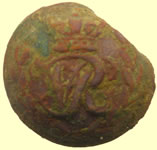 |
|
| 1500-1700 mount | WWII RAF button | Victoria Royal Engineers button | |
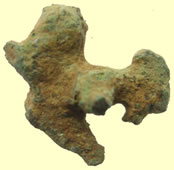 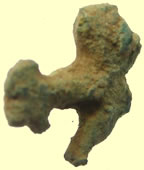 |
|
||
| Roman period mount | Roman lynch pin | ||
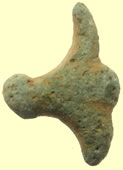 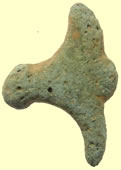 |
  |
||
| Roman period mount | 1247 Henry III hammered silver voided long cross half penny Rev /ON/LV - London mint |
||
 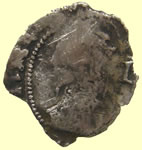 |
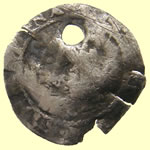 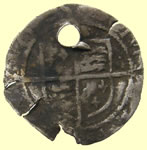 |
||
| 1634 Charles 1st hammered silver penny | 1560-1 Elizabeth 1st hammered silver penny | ||
  |
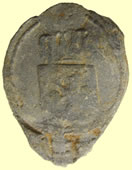 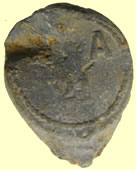 |
||
1247 Henry III hammered silver voided long cross half penny Rev /*LE/OH - Nicole of Canterbury mint |
17thC Dutch lead bale seal | ||
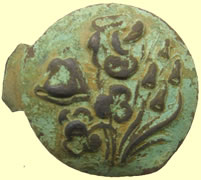 |
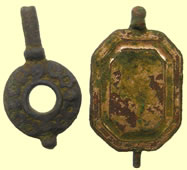 |
 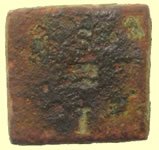 |
|
| Georgian pill box lid | Georgian watch winders | 1797-1813 gold 1/3 guinea coin weight Obv 7S |
|
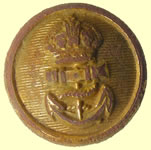 |
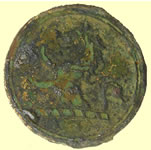 |
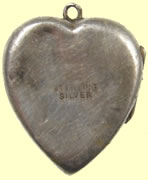 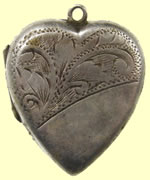 |
|
| WWII Navy button | 19thC livery button | Victorian silver locket | |
 |
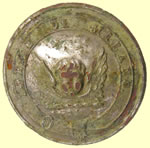 |
 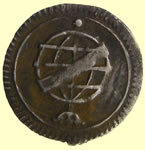 |
|
| 1500-1700 mount | 19thC livery button | 1750-1770 20 Real Joseph I Portuguese silver coin |
|
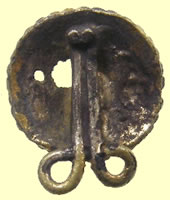 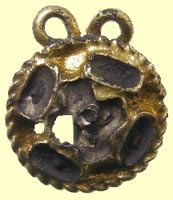 |
|||
| 17thC gilded silver clothing fastener - reported as treasure to museum | |||
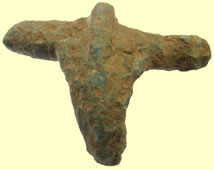 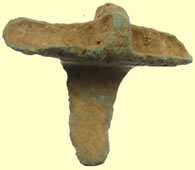 |
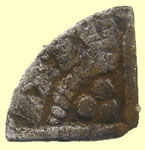 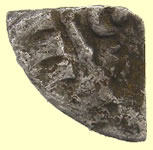 |
||
| 1stC Roman head stud type fibular brooch | 1247 Henry III hammered silver voided long cross farthing | ||
50 BC Clacton type Celtic gold qtr stater - sent to CCI for recording and reported as potential hoard to museum This example clearly shows the gold, copper, silver mix of these coins 13.62,1.33g |
|||
 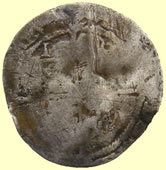 |
 |
 |
|
| 1561 -5 Elizabeth hammered silver three pence - Pheon mint mark | 18thC Royal Navy silver button | 17thC lead token | |
4th C Roman bronze coin sent for ID Although I rotated the reverse image through an entire 360º searching for some telltale familiar shape that might allow me to categorize and date this piece more closely, I was unable to come up with any determination that satisfied me. The obverse, however, has just enough detail showing in the legend that I can tell you with a reasonable degree of certainty that I believe this to be a reduced follis or centenionalis of Constantine I (307-337). He introduced the centenionalis to replace the sadly diminished Diocletianic follis - reduced to a mere shadow if its original module - in about 319. Licinius, being Constantine's perpetual antagonist at the time, continued to mint folles at the mints he controlled in the East until his ultimate defeat and death in 324. Ironically, the two denominations are so similar in size and weight that most folks don't realize there's any difference between Licinius' last folles and Constantine's earliest centenionales. At any rate, I'd guess that this piece, whatever the reverse type may turn out to be, would probably date to the late teens on through the twenties of the 3rd century. Mark |
|||
 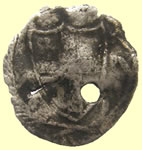 |
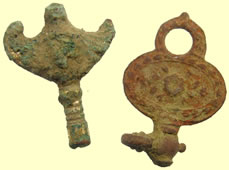 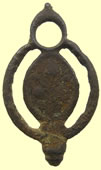 |
||
| 1649 Commonwealth hammered silver penny | Georgian watch winders | ||
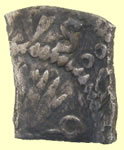 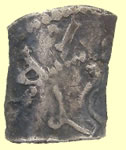 |
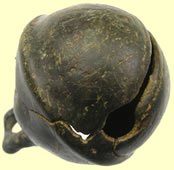 |
||
| 15thC Spanish 8 real | 17thC crotal bell | ||
|
|||
Cleaned up Saxon rope necklace end - single rivet fixing Beast with large bottom jaw, large nose, recessed eyes with his head resting on his paw left - rear shows curled up spiralled tail. Rope necklace is still embedded in end |
|||
 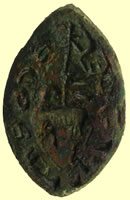  |
|||
| Cleaned up crusty 13thC vessica seal matrix - sacrificial lamb type | |||
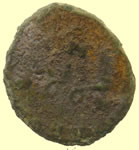 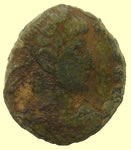 |
|||
4thC Roman bronze coin sent for ID What you need to do is rotate the image of the reverse about 165º clockwise and you'll see it looks like this with a pair of wreaths between a pair of heads which face inward: What we have on the reverse of this "Æ4" is a pair of Victories facing each other, each one holding up a wreath (we've had kids in the ACE program who insisted they saw "angels playing badminton" on these) This type was part of the very final issue of the Constantinian Centenionalis (introduced by Constantine I in about 319) these final-issue Centenionales date to 346-7, just before Constans and Constantius II introduced the reformed, Majorina-based coinage, the most comonly seen examples of which are the FEL TEMP REPARATIO types - and the most common of those types is the soldier spearing the unfortunate fallen horseman. This type, however, is VICTORIAE DD AVGG Q NN - ("[to] the Victories of our two Emperors") Two Victories holding wreaths - This type was struck only by Constans, who was not long for the world at this point - he was killed in 350 by Magnentius in Hispania - and Constantius II who, as sole ruler of the Roman world, would issue all those soldier-and-horseman pieces for the next 13 years. (You might recall a hoard of Æ3's you had last year with a bare-headed emperor's portrait, and the haircut that looks like a classic greaser's "DA" - interestingly, the most common reverse of Magnentius and his brother Decentius is a somewhat different 2-Victories reverse type - http://www.stoa.org/gallery/album167/29_Magnentius_2VIC_TRP ) A more completely visible Constantius specimen would look like this: and a Constans looks like this: So you should be able to see why, if none of the obverse legend is legible, it's not really possible to tell which one of the two is on a particular coin. I can tell you however, despite the lack of legible exergual mint mark on your piece, on the basis of the M visible in the lower field between the 2 Victories that it's most likely to be from the mint of Trier. Lugdunum also used an M in the field, but on a single very rare issue of these, so Trier is by far the more probable place of origin. Mark |
|||
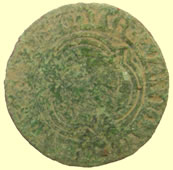 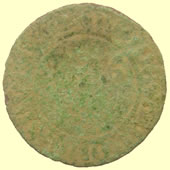 |
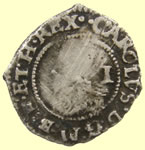  |
||
1586 Hans Krauwincel II Rose orb Jetton HANNS KRAVWINCKEL IN NVRENB |
1641-3 Charles 1st hammered silver penny - mintmark 2 dots
|
||
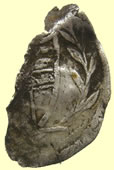  |
 |
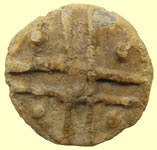 |
|
| 1649 Commonwealth hammed silver half groat | 17thC lead token | 17thC lead token | |
|
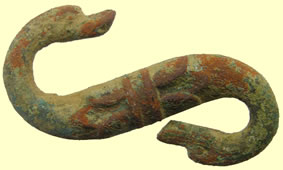 |
||
| Georgian pewter domino | 16thC S buckle | ||
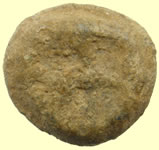 |
 |
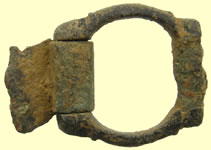 |
 |
| Medieval lead trade weight | Victorian silver fob chain bar | 1250-1500 D buckle |
Post-medieval copper-alloy buckle frame C AD 1650-1720 |
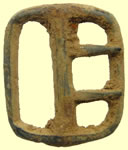 |
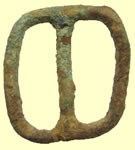 |
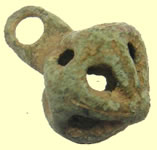 |
 |
1720-1790 Boot or Garter buckles |
Post Medieval cast copper alloy single loop buckle frame. 1500-1650 AD |
16thC Tudor button | 18thC flint lock pistol handle plate |
 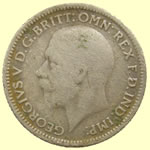 |
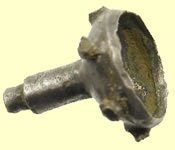  |
||
| 1928 George V milled silver sixpence | 18thC silver mount | ||
  |
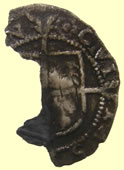 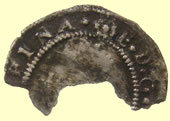 |
||
1215 Henry III hammered silver half penny
|
1565 Elizabeth 1st hammered silver half groat -= Rose mint mark | ||
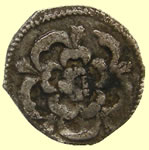 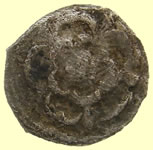 |
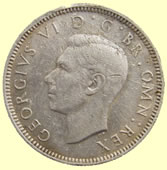  |
||
1625-42 Charles 1st hammered silver half penny - Rose each side |
1942 George VI milled silver shilling (12 pence) | ||
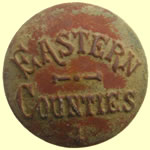 |
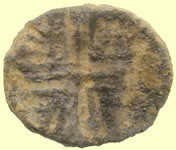 |
 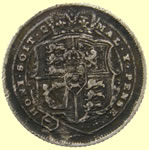 |
|
| Eastern Counties bus company | 15thC lead token | 1817 George III milled silver sixpence | |
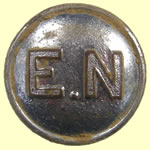 |
 |
  |
|
| Eastern National bus company | 18thC 29th Regiment of foot button | 1300-10 Edward 1st hammered silver farthing - type 28d Obv EDWARDVS REX A Rev CIVI/TAS/LOND/DON - London mint |
|
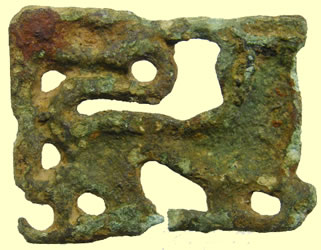  |
|||
| Large C8thC Saxon mount | |||
Monster rare coin ID'd Frisian imitation (c.830-850) |
|||
Wierd ancient coin - looks like a Roman but with more medieval style lettering - sent off to both medieval and Roman experts for their views This is copper alloy plated imitation of a Frisian imitation (c.830-850) of the gold solidus of Louis the Pious (814-840). There have been many single finds of these Frisian imitations, including cut fractions of them, but this is the first plated copy I have seen. I have recorded this as EMC 2013.0106. If it should ever be available to acquire please let us know. Best wishes, Martin
|
|||
Date: Medieval, 1200-1400 AD. Description: A complete silver annular brooch dating to the Medieval period. The frame is circular in section and in plan. The pin, also silver, is rectangular in section and bent around the frame to form an attachment loop of almost a complete circle. The shaft of the pin extends away from the loop, becoming circular in section and tapering to a blunt point. The pin has suffered some damage and bent in the centre of the shaft whilst the attachment loop has been bent to one side. This could have occurred during use. The object is classified as a buckle rather than a brooch as there is no constriction for the pin. Several similar examples have been recorded through the Treasure process on the PAS database (e.g. IOW-D6F125 / 2009 T106 and SWYOR-9EF3B5 / 2010 T820). The frame measures 18.5mm in diameter and 1.9mm in thickness. The pin measures 20.7mm in length and 1.6mm in width at the centre of the shaft. The brooch weighs 1.74g. |
|||
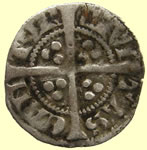 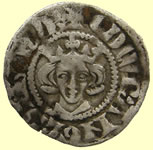 |
  |
||
1344 Edward III hammered silver penny - Florin type Obv EDWR ANGL DNS YB Rev CIVI/TAS/CAN/TOR- Canterbury mint |
1604 James 1st hammered silver half groat | ||
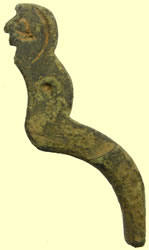 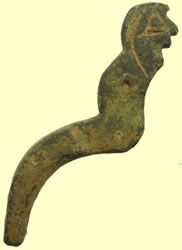 |
|||
| Medieval nut cracker arm with face decoration | |||
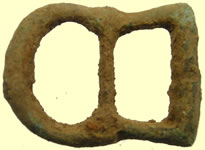 |
 |
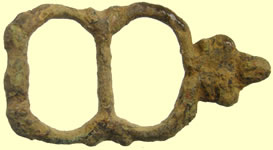 |
|
A complete cast copper alloy buckle of post-medieval date. The buckle is a double loop asymmetrical shape Circa 1575- 1700 |
18thC toy cannon | Post Medieval cast copper alloy single loop buckle frame. 1500-1650 AD |
|
 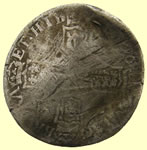 |
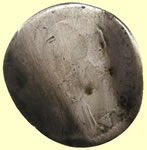 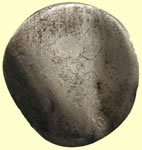 |
||
| 1696 William III milled silver sixpence | 1696 William III milled silver sixpence - love token | ||
 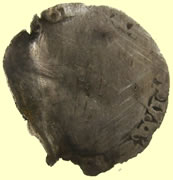 |
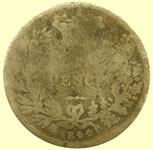 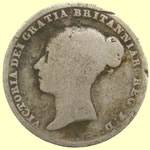 |
||
| 1554 Mary hammered silver groat | 1844 Victoria milled silver sixpence | ||
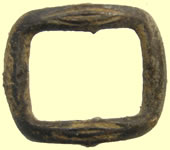 |
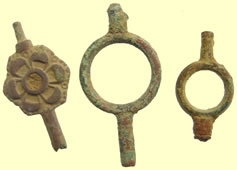 |
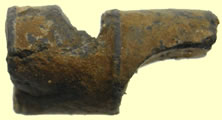 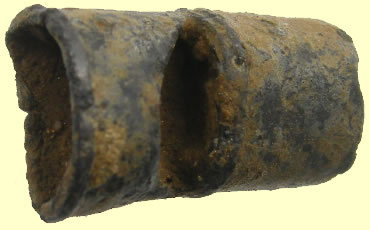 |
|
Post-medieval copper-alloy buckle frame C AD 1650-1720 |
Georgian watch winders | Victorian whistle | |
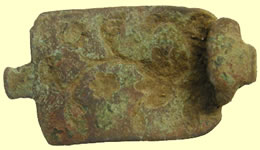 |
 |
 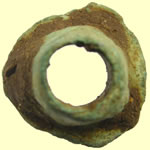 |
|
| 18thC clog fastener | 17thC lead token | Roman bronze mount | |
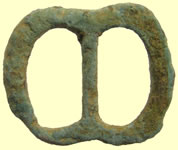 |
 |
 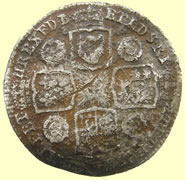 |
|
Post Medieval cast copper alloy single loop buckle frame. 1500-1650 AD |
Georgian watch winder | 1740's issue George II milled silver shilling (12 pence) Old bust, roses | |
 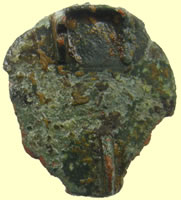 |
|||
| 1stC Celtic enamelled triskele disc brooch - Ref Hattatt 525 Page 143, Crummy, N1983, PL.14.82 | |||
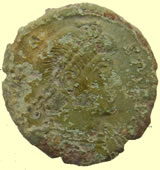 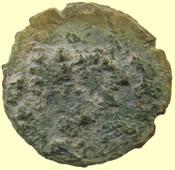 |
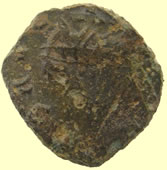  |
||
4thC Roman bronze coin sent for ID 1.97g, 16.82mm Im not 100% sure about the reverse type, as deeply encrusted as it is, but I can read the obverse adequately to say the emperor is Constans - one of Constantine I's sons - 337-350 AD. http://www.stoa.org/gallery/album166/15_Constans_2Vic_TRE Mark |
4thC Roman bronze coin sent for ID 1.44g, 15.64mm – Bronze 1 This appears to be a contemporary copy of a "Quinarius" - a smaller-size radiate, presumably valued as half the antoninianus - of British emperor Allectus - with the galley reverse - like this (except yours is unoffical and the legend is blundered, etc) or it could just be a very crude official piece: http://www.stoa.org/gallery/album85/ML_09_Allectus_Virtus_ant2 Mark |
||
  |
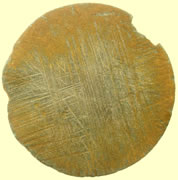  |
||
1496- 1504 Henry VII hammered silver half groat - Tun mint mark - Double arched crown Obv HENRIC DI GRA Rev CIVI/TAS/CAN/TOR - Canterbury mint |
1509 Henry VIII trade weight - Crown h cipher - unusual flat design | ||
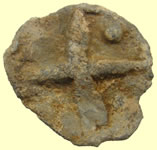  |
 |
||
| Very unusual double sided type 2 medieval lead token | Downing of Manningtree and Clacton on Sea advertising watch winder | ||
Medieval badges Ref Mitchiner p244 939 - 941
|
|||
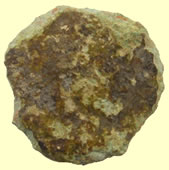 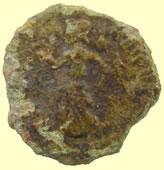 |
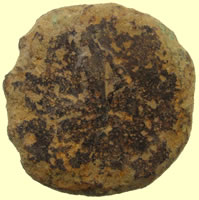  |
||
4thC Roman bronze coin sent for ID 1.99g, 15.39mm This is a little later than what you seem to usually find. It's a SECVRITAS REIPVBLICAE Æ3. These were struck for about 6 different emperors in the Valentinian dynasty, but are overwhelmingly more common for the first 2 - Valentinian I and Valens. I can't tell which of the 2 this is: http://www.stoa.org/gallery/album82/A_13_SisVi_SecReip1 Mark |
1stC Roman bronze coin sent for ID 15.71g, 29.29mm This one I can't be 100% certain about, but from the size and weight, it's a sestertius. I believe, since the bust appears to be bare-headed and Caesars were portratyed bare-headed in the 3rd century, that this is Marcus Aurelius as Caesar under Antoninus Pius, 139-161. I don't know what the reverse is - it seems to be a seated figure left. Usually the seated figures are female, but this somehow looks male so it might be Zeus who is commmonly portrayed seated to the left. If it's a standing figure, it might be Virtus - a popular subject for Caesars' large bronzes: http://www.stoa.org/gallery/album94/M_Aurel_Caes_Virtvs_Sest1 Mark
|
||
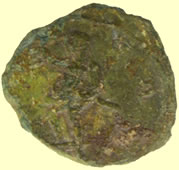 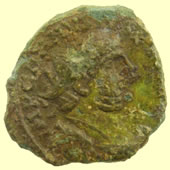 |
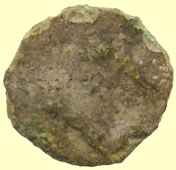 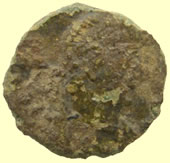 |
||
4thC Roman bronze coin sent for ID 2.84g ,20.57mm You have had surprisingly few coins of the British Empire over the years - this lot contains at least 3 - this is the 2nd. It's Carausius, 287-293, and I'm pretty sure the reverse is the typical PAX AVG like this: http://www.stoa.org/gallery/album85/ML_03_Carausius_Max_Pax_ant2 Mark |
4thC Roman bronze coin sent for ID This, I believe, is another VICTORIAE DD AVGG Q NN - 2 Victories facing each other and holding wreaths. It wold be either Constans or Constantius II, these were issued only in the years 346-7. http://www.stoa.org/gallery/album166/16_Constantius_2Vic_ROM Mark |
||
 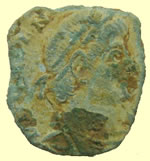 |
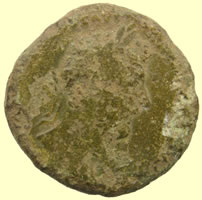 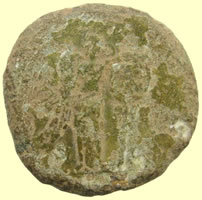 |
||
4thC Roman bronze coin sent for ID 1.20g, 13.69mm This is Valens, 364-378, another SECVRITAS REIPVBLICAE like # 5 - we can almost make out the mint mark, but not quite, although I think it's an Eastern mint by the format: SMXX http://www.stoa.org/gallery/album82/A_26_ConVn_SecReip Mark |
1stC Roman bronze coin sent for ID 19.53g, 30.91mm This is a Sesterius of Marcus Aurelius, 161-180 (I believe it is - it might be his co-emperor Lucius Verus), in honor of one of his victories - the reverse is Victory standing right hanging a shield inscribed "VIC / PAR" or "VIC GERM" etc on a palm tree. http://www.stoa.org/gallery/album96/ML03_Verus_Vic_Par_sest?full=1 Mark |
||
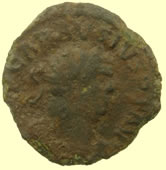 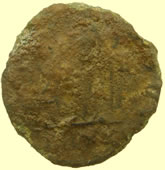 |
 |
 |
|
4thC Roman bronze coin sent for ID 3.83g, 21.37mm This is the 2nd Carausius (3rd British Empire piece) It's most likely PAX AVG again - that's by far the most common reverse type, but there's a slight chance this is Victory standing left. http://www.stoa.org/gallery/album85/ML_06_Carausius_Fortuna_ant Mark |
Infanterie de ligne (1871-1916) |
Musket ram rod guide | |
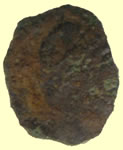  |
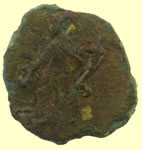  |
||
4thC Roman bronze coin sent for ID 0.61g, 11.55mm This is one of the 2 Victories facing each other holding wreaths type - VICTORIAE DD AVG Q NN - the final emission of the Centenionalis denomination, struck only for Constantius II and Constans in 346/347 - the obverse is too far gone to tell which of the two it is. This one has a symbol between the Victories - an ivy leaf on a stem. This symbol was only used in Trier and Rome. Given the normal sourcing for those coins you dig which show an identifiable mint mark, I'd have to say Trier is the more likely of the two |
4thC Roman bronze coin sent for ID 1.14g, 15.5mm This one I'm not 100% certain about - again, no legend at all is a serious handicap to attribution. |
||
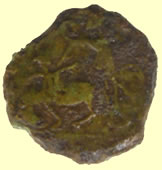  |
 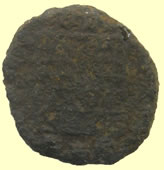 |
||
4thC Roman bronze coin sent for ID 1.52g, 13.86mm For this one, at first I was going to say: "I'm pretty certain this is not a Roman coin - I can't find any recognizeable features, I've turned and turned it and I can't make the either side resolve into anything clearly recognizeable, despite a lot of bold detail." |
4thC Roman bronze coin sent for ID 1.75g,, 16.69mm This is what is referred to as a "Campgate" - although it's highly unlikely that the gate of an army camp was what was meant to be portrayed. |
||
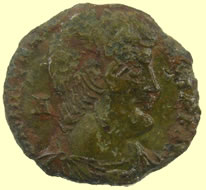 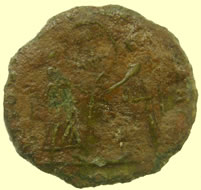 |
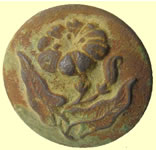 |
 |
|
4thC Roman bronze coin sent for ID 3.59, 20.69mm This is a larger piece - a Majorina - of the Western semi-rebel emperor Magnentius who, with his younger brother Decentius, was around for a couple years - 350-353. This is yet another sort of 2 Victories reverse. This is somewhat like the VICTORIAE LAETAE's of Constantine's a generation earlier. The legend here is VICTORIAE DD NN AVG ET CAE and the 2 Victories are holding a wreath enclosing VOT / V / MVLT / X . |
Georgian button | Medieval buckle handle mount | |
|
|||
| Medieval decorated strap end | |||
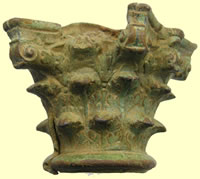  |
|||
| Georgian candle holder | |||
  |
|||
1346-1361 Edward III gold half noble - Closed E at centre of cross - satire stops Needs straightening for a confirmed ID 4.12g |
|||
 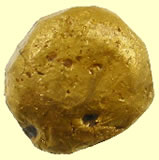 |
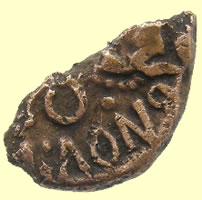 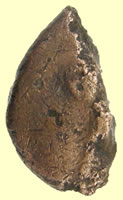 |
||
Saxon gold ingot - reported as treasure to museum 3.21g, 8.43mm dia |
Broken Celtic gold full stater - not checked the ref books yet Sent to CCI for recording 1.68g, 13.74mm The broken stater can be 13.0083. By coincidence I was looking at these yesterday, it's a Dubnovellaunos in Essex stater, ABC 2392, BMC 2425-2440, Van Arsdell 1650; there should be just enough of the legend showing to be able to die link the reverse. It's not a particularly rare type, over 100 in the Index at present. Hope the rest turns up, it's not unknown for different fragments of the same coin to turn up years apart! All the best John |
||
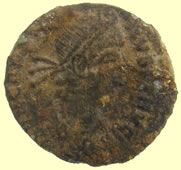  |
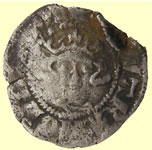 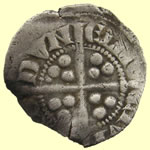 |
||
4thC Roman bronze coin sent for ID This one is very easy. Constantius II, the type is FEL TEMP REPARATIO - soldier advancing left and spearing fallen horseman. The mint is Lugdunum (Lyons) - I'll even hazard a catalog reference - RIC VIII, Lyons 189 or 196, 6 November 355 - Spring 360. The mint mark is either GPLG or RPLG, respectively for the 2 numbers cited. |
Facinating unknown 1335 Edward III hammered silver penny- this does not match either transitional period or class 15d so it could be one of the unknown 2nd coinage 1335 -1343 issues New legend for a Durham mint as it should be either DOR/ELME or DVN/ELMI but this is clearly DVN/ELME Obv EDWAR ANGLE DNS *** Rev CIVI/TAS/DVN/ELME -Durham mint |
||
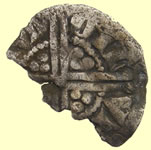 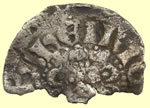 |
  |
||
1247 Henry III hammered silver voided long cross penny Obv - HENRICVS REX Rev *VD/ONL/VN* - Moneyer Renavd of London mint
|
1216 Henry III hammered silver short cross half penny Obv - HENRICVS REX Rev Moneyer Wiilem of Canterbury mint |
||
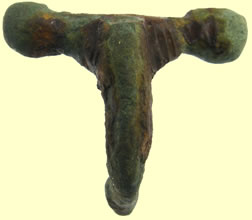 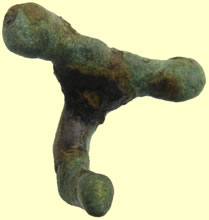 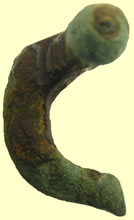 |
|||
| Roman fibular brooch - similar to a 3rdC cross bow brooch without the cross - no obvious matches in Hattatt so one for the museum | |||
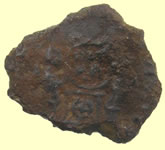 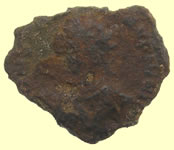 |
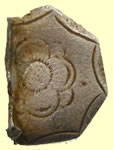 |
||
4thC Roman bronze coin sent for ID This is a VICTORIAE LAETAE PRINC PERP type - 2 Victories facing each other and holding a shield inscribed VOT / PR above a small altar with a symbol - a cross within a wreath - on the altar. This symbol was used only at the London mint. These were struck for all the members of the families of Constantine I & Licinius around 319 - they are part of the first emission of the Centenionalis denomination which would be ushered-out by the VICTORIAE DD AVGG Q NN's the type with 2 Victories holding wreaths, of 346 & 347, the final examples of the sadly shrunken and debased denomination.
Mark |
18thc silver Royal Navy button | ||
Bronze Age (c.1500-1400BC) cast copper alloy primary shield pattern palstave, dating to the Acton Park Phase 68.25mm L x 29.97 734g |
|||
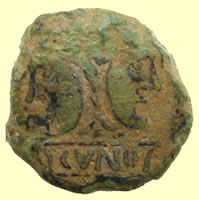 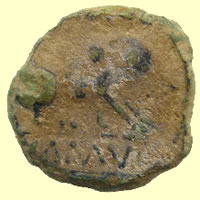 |
|||
10-40AD Cunobelin Celtic bronze unit Obv Janus head below CVNO, inside quad.o,pellet border Rev boar std,below CAMV,inside quad.o,pellet border 1.52g,13.88mm |
|||
 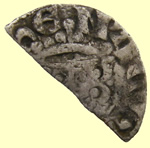 |
 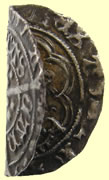 |
||
1247 Henry III hammered silver voided long cross penny Obv - HENRICVS REX Rev /NDE/IDO/ - Moneyer David of London mint |
1486 - 1504 Henry VII hammered silver half groat - one plain and one jeweled arch to crown - im Cross pattee - im Obv Tun Obv HENRICVS.DI.GRA. REX AGL Z R Rev CIVI/TAS/CAN/TOR - Canterbury mint |
||
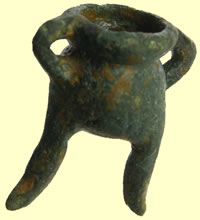   |
|||
Roman bronze miniature votive offering pot 21.83mm h x 21.84mm w, 7.04g |
|||
 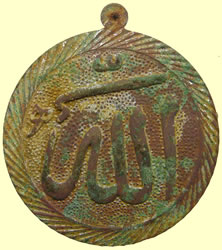 |
|||
| Huge 3 inch diameter Arabic looking medallion ? | |||
 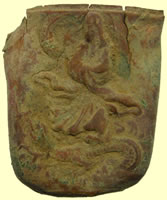 |
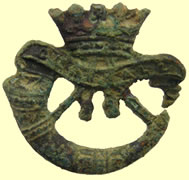 |
||
| Georgian vesta case | Duke Of Cornwall Light Infantry Regiment | ||
 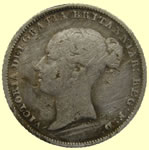 |
 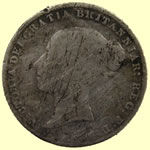 |
||
| 1853 Victoria milled silver sixpence | 1863 Victoria milled silver sixpence | ||
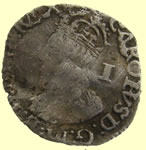 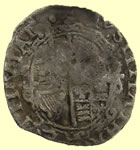 |
 |
||
1641-3 Charles 1st hammered silver penny - mintmark 2 dots |
2 - Georgian jewelry items | ||
  |
|
||
| Different design of a medieval bronze pot foot | Low grade gold ingot | ||
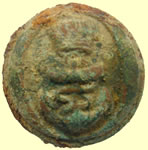 |
 |
||
| Continental Navy button | Essex Constabulary button | ||
|
|||
| Biggest 11,000 BC flint axe head I have ever seen - it is a monster and weighs 580g, 220mm L x 54.6 mm W | |||
 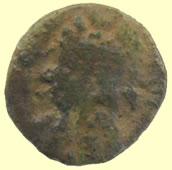 |
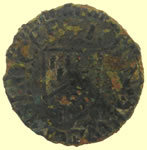 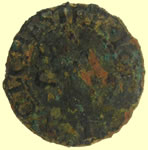 |
||
Mid 4thC Roman Constantine bronze coin Shewolf & Twins reverse which is typically found on the VRBS ROMA, City of Rome commemorative, reduced-module folles introduced around 330 AD., |
1667 John Sewell, grocer of Colchester Essex hammered copper trade farthing | ||
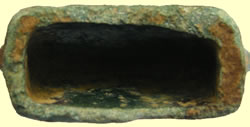 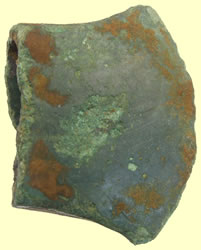 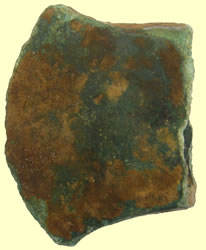 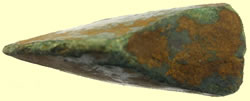 |
|||
Middle Bronze age 850 BC socketed bronze axe head 49.8mm w x 38.9mm L |
|||
Penn Dennis' crispy Roman silver is start to 'cook' up after being in the pot since March 2012 !! Finally finished the obverse legend is DIVA FAVSTINA ("the deified" Faustina) and portrays her in the usual way with a fairly elaborate hairstyle, somewhat swept up in the back with a small bun at the top of the head. Faustina Sr.for him - a posthumous piece (as is the majority of her coinage) for the wifeof Antoninus Pius. She died in 141, only 3 years into Antoninus' longreign, and had significant posthumous coinages struck in her honor, first byAntoninus Pius, then later by Marcus Aurelius - her son-in-law. Mark |
|||
The 'cooking' process clearly shows the thickness of the horn crust on this coin 10- 40 AD Cunobelinus 'Sitting Griffin' type silver unit - Classed as extremely rare VA 2051, BMC 1868-9 Chris Rudd 30.73 Cooking to clean up and sent to CCI for recording and confirmed ID Rev CVNO in tablet, wrealth border Obv Griffin r - on tablet containing CAMV I've done a card for the Sitting Griffin unit and it's now CCI 12.0835; I've used the photo you sent but will replace it with a better one when the coin's 'cooked'!
All the best John |
|||
 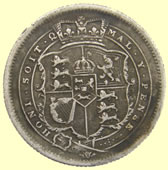 |
|
||
| Mega crisp 1816 George III milled silver shilling (12 pence) | Victorian 5 shillings Insurance reward tag - Glosgow 19 Newton Place, Charing Cross Rd Glasgow |
||
 |
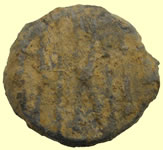 |
  |
|
| Victorian silver bird mount | 17thC lead token | Medieval copper alloy belt mount Date from: AD 1100 |
|
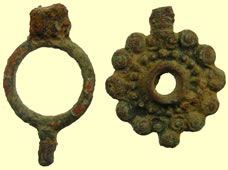 |
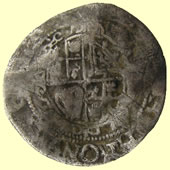 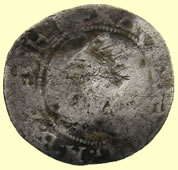 |
||
| Georgian watch winders | 1639-40 Charles 1st hammered silver half groat - Triangle mint mark | ||
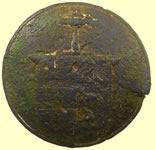 |
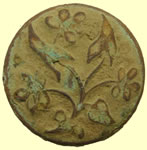 |
 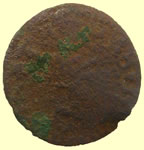 |
|
| 19thC livery button | Georgian button | 17thC Thomas Reynolds bays maker of Colchester hammered copper farthing - undated type |
|
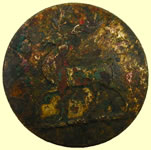 |
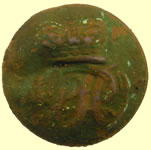 |
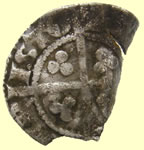 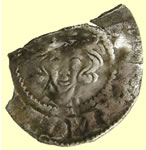 |
|
| 19thC livery button | Georgian Royal Engineers button Crown GR |
1272 Edward 1st hammered silver penny - Class 3 Obv EDWR ANGL DNS HYB Rev BR/ISTO/LL** - Bristol mint |
|
  |
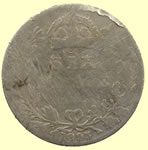 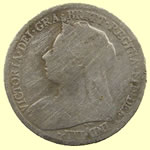 |
||
| 1835 William IV milled silver sixpence | 1895 Victoria milled silver sixpence | ||
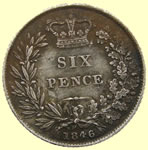  |
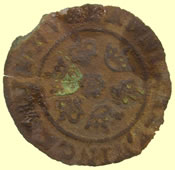 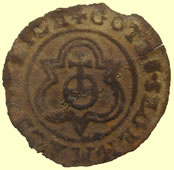 |
||
| 1846 Victoria milled silver sixpence | 1586 Hans Krauwincel II Rose orb Jetjon HANNS KRAVWINCKEL IN NVRENB |
||
 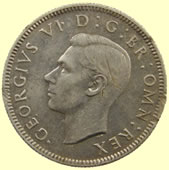 |
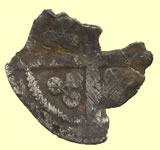 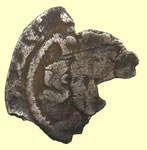 |
||
| 1943 George VI milled silver shilling | 1369- 1377 Edward III hammered silver penny - Post Treaty Obv *** ANC |
||
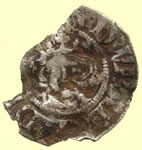 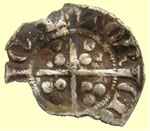 |
 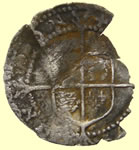 |
||
1344 Edward III hammered silver penny - Florin type Obv EDWR ANGL DN *** Rev CIVI/TAS/CAN/TOR - Canterbury mint |
1578-9 Elizabeth 1st hammered silver penny - mint mark Greek cross | ||
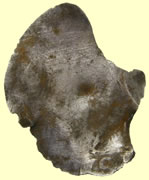 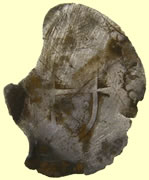 |
 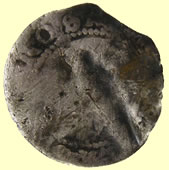 |
||
| 1554 Mary hammered silver groat | 16thC Elizabeth 1st hammered silver half groat | ||
  |
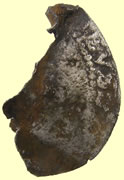 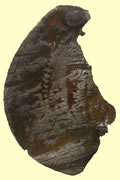 |
||
| Taco'd Medieval hammered silver short cross penny - needs fixing to ID | 1603 James 1st hammered silver sixpence | ||
 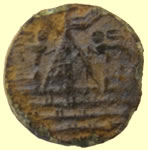 |
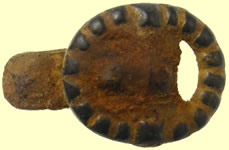 |
||
| British 15thC gold noble coin weight - ship with 2 Lion type | Post medieval cast copper alloy rectangular two piece buckle C1650-1725 |
||
This is a very early piece of gold jewelry as what looked initially gold plated is actually solid gold and the black crust matches the growth recently found on low grade Celtic gold coins. I exposed small parts of the black to reveal the gold but cannot clean it up any further as treasure has to sent to the museum in as dug condition. Putting it under a scope you can clearly see where a central intaglio or similar was probably fitted. One for the museum experts but what a great find - At a guess I would vote Roman and possibly an ear ring. 1.28g, 20.69mm L |
|||
 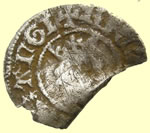 |
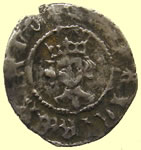 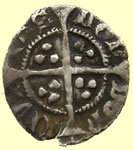 |
||
1377-1399 Richard II hammered silver half penny Obv + RICARD x REX : ANGL Rev CIVI/TAS/LON/DON - London mint 0.37g, 12.93mm |
1399 1413 Henry IV hammered silver half penny - light coinage - Type 1 Obv + hENRIC x REXx ANGL' Rev CIVI/TAS/LON/DON - London mint 14.40mm,0.48g |
||
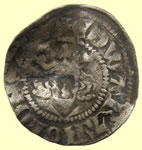 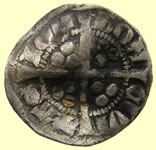 |
  |
||
1344 Edward III hammered silver penny - Florin type Obv EDWAR ANGL DNS HYB Rev CIVI/TAS/LON/DON - London mint 19mm,1.35g |
1625 Charles 1st hammered silver half groat | ||
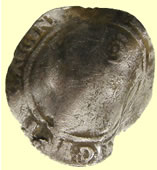  |
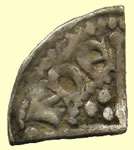 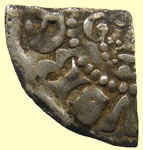 |
||
| 1578-9 Elizabeth 1st hammered silver half groat - Greek cross mint mark | 1247 Henry III hammered silver voided long cross farthing Obv HENRICVS REX Rev /NDE/ - London mint |
||
 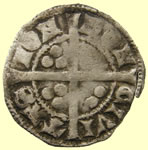 |
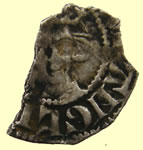 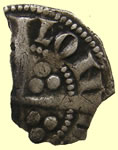 |
||
1344 Edward III hammered silver penny - Florin type Obv EDWAR ANGL DNS HYB Rev CIVI/TAS/LON/DON - London mint
|
Edward Ist to 3rd hammered silver penny Obv ***ANGL Rev CIVI/TAS/LON/DON - London mint |
||
  |
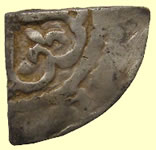 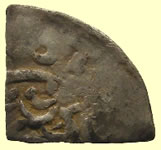 |
||
1247 Henry III hammered silver voided long cross half penny Obv HENRICVS REX Moneyer Nicole of Londion mint |
Continental hammered silver farthing | ||
 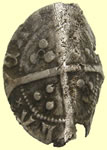 |
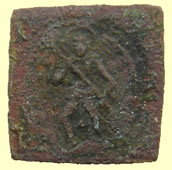  |
||
1422-27 Henry VI hammered silver penny - Annulet issue Annulets by neck, annulets in opposing quadrants in reverse cross Obv HENRICVS REX Rev VIL/LA/CAL/ISIE - Calais mint |
15thC Angel figure qtr gold noble coin weight 2.02g Obv RVE |
||
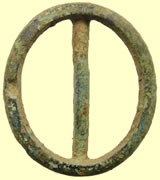 |
 |
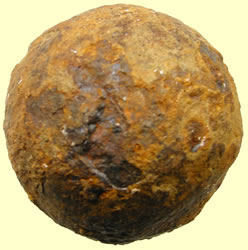 |
|
| Medieval baldric buckle | Early-Medieval (Anglo-Saxon) single looped buckle frame (c. 450-600). |
1648 English Civil War 3/4lb cannon ball - 1.5 inch dia The shot was probably used in a small calibre gun such as a robinet or a falconet The siege of Colchester occurred in the summer of 1648 when the English Civil War reignited in several areas of Britain. Colchester found itself in the thick of the unrest when a Royalist army on its way through East Anglia to raise support for the King, was attacked by Lord-General Thomas Fairfax at the head of a Parliamentary force. The initial Parliamentary attack forced the Royalist army to retreat behind the town's walls but was unable to bring about victory, so settled down to a siege. |
|
 |
 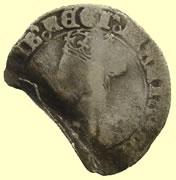 |
||
| 1826 Trade weight - City of London mark 'Guildhall' | 1554 Mary hammered silver groat | ||
  |
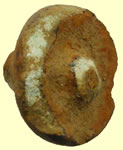  |
||
| 1214-49 Scottish Alexander II hammered silver half penny | Roman bronze mount | ||
 |
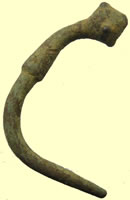 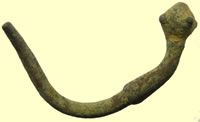 |
||
| 17thc crotal bell | Medieval purse bar arm with knopped end | ||
 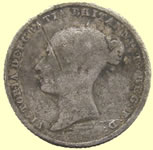 |
  |
||
| 1840 Victoria milled silver sixpence | 1344 Edward III hammered silver penny - Florin issue Obv EDWAR ANGL DNS HYB Rev CIVI/TAS/LON/DON - London mint |
||
  |
 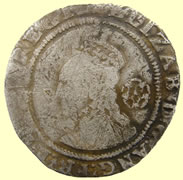 |
||
| 1625 Charles 1st hammered silver penny | 1583 Elizabeth 1st hammered silver six pence | ||
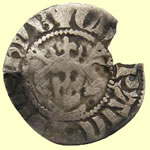 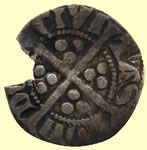 |
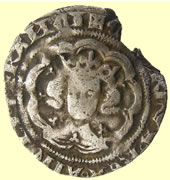  |
||
1344 Edward III hammered silver penny - Florin issue Obv EDWR ANGL DNS HYB Rev CIVI/TAS/LON/DON - London mint |
1351 - 3 Edward III hammered silver half groat - Pre Treaty series C Closed C & E, 9 arches to tressure - no trefoils over crown Obv EDWARDVS REX ANGLI Z FRANCI Rev CIVI/TAS/LON/DON - London mint |
||
  |
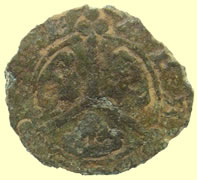  |
||
1589 Hans Krauwinckel German Jetton Obv Europa riding bull on right, across waters of river Ravi Rev Venus , accompanied by her attribute, a small cupid with his bow, standing naked between Pallas and Juno PALLAS LVNO VENVS Ref Mitchiner 1611 |
Unknown type with *I* I on Obv instead of pellets 1321 Edward II English jetton - Bust type Class XI Obv Edward bust with succession of * and I Rev Three armed cross, in each angle a 'facing bare human head ' border,, succession of letters B and S Similar Ref Mitchiner 131 but with different legend |
||
 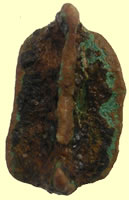  |
|||
| Medieval red and yellow enamelled belt slide decoration | |||
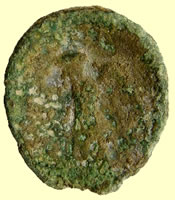 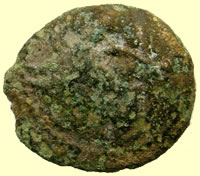 |
|||
10 to 40 AD Celtic bronze unit - Cunobelinus Pegasus Victory left ABC 2921 - sent to CCI for recording ABC 2921 type as CCI 13.0095 |
|||
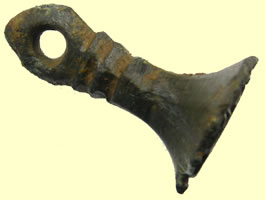 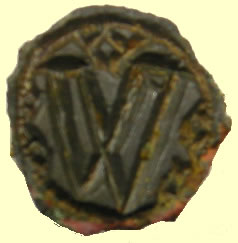 |
|||
| 13thC medieval seal matrix - letter W indicates traders initial | |||
  |
|||
10-40 AD Cunobelius bronze coin - sent to CCI for recording Jupiter Lion type VA 2107 1.07g, 12.56mm ABC 2984 as CCI 13.0096
|
|||
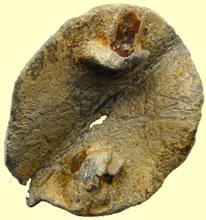 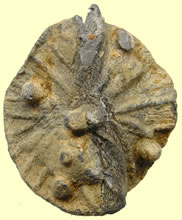 |
 |
||
Fascinating large medieval lead brooch or mount - pin fixing on back like a brooch Not seen one before |
19thc hunting button | 16thC Tudor button | |
 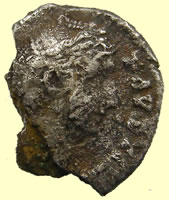 |
|||
2ndC Roman silver sent for ID the broken silver piece will need more study - Sorry to say, this does not "jump off the page" for me. I don't recognize the portrait or even the fragment of legend at first glance. It does seem to be either Roman or Roman-inspired at very least, however - which makes it all the more puzzling for me since I am pretty familiar with the entire field. Mark |
|||
|
|||
| Stunning decorated circa 8thC Saxon strap end | |||
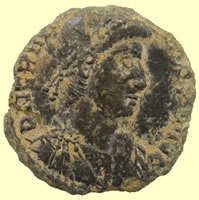  |
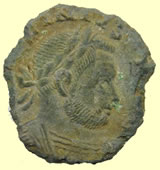 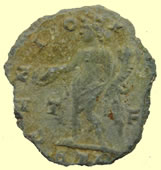 |
||
4thC Roman bronze sent for ID 21.29mm ,3.85g This is pretty unusual given the sort of material you generally seem to find since it's a good bit later - it appears from the legend to be Gratian - 367-383 and the reverse type is definitely REPARATIO REIPVB with Gratian standing left raising a kneeling female figure - an allegorical representation of "The Republic" - pure propaganda, the Empire was in pretty dire straits at that time and having its lunch-money stolen in the schoolyard daily by every bully on the borders. Mark |
4thC Roman bronze sent for ID 17.36mm, 1.16g This is a follis of someone from the 2nd tetrarchy - the reverse type is GENIO ... (could be EXERCITVS, IMPERITORI, CAESARIS, AVGVSTI, POPVLI ROMANI or POP ROM ) This issue dates to 310-313 - I think we can say it's Licinius without too much uncertainty, and the only thing which remains uncertain is the exact mint from which it was issued - could be London, Trier or Lyon (but I lean towards London, although the center letter could be a T, in which case it's Trier) |
||
  |
|||
| Stunning zoomorphic decorated circa 8thC Saxon strap end | |||
  |
  |
||
| 2ndC Roman fibular brooch | Great shape 1754 George II milled copper farthing | ||
 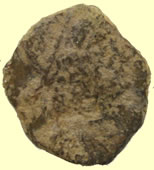 |
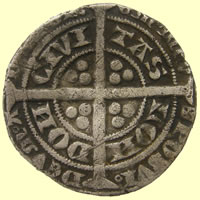 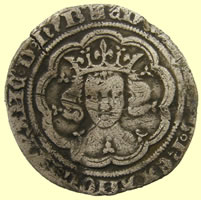 |
||
4thC Roman bronze sent for ID The "British Copy" was a pretty good guess on your part - this does seem to be a generic contemporary copy of a Tetricus I PAX AVG type antoninianus Mark |
1351- 1361 Edward III hammered silver groat - Cross 1- Pre Treaty period Obv EDWARD D G REX ANGL FRANC D HYB Rev CIVI/TAS/LOND/DON - London mint |
||
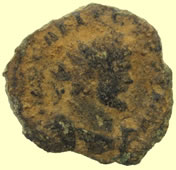  |
  |
||
4thC Roman bronze sent for ID This is a "Quinarius" - or radiate half-antoninianus - of Allectus. He suceeded Carausius as emperor of the British Roman Empire, c. 293-296. He suceeded chronologically, but as a ruler/conqueror, was not so much of a success. |
1247 Henry III hammered silver voided half penny Moneyer Walter of Canterbury mint |
||
 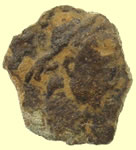 |
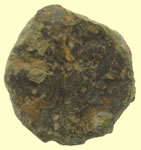 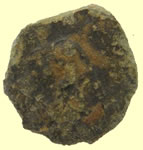 |
||
Clipped 4thC Roman bronze sent for ID Your final 2 pieces I won't bother to try to illustrate - you can tell they're in pretty bad shape. Those would be chipped rather than clipped, BTW. No one ever bothered to clip or shave the edges of bronze coins - that was really only done with silver or gold - and even then it was not very productive since any questionable-looking coin would be likely to be weighed when changing hands. The vast majority of clipped pieces (aside from the cut or broken halves and quarters made in the name of small change) were officially clipped earlier types which were made smaller to circulate beside later, smaller types. Roman siliquae were officially clipped wholesale to comply with the weight standard of the Saxon sceattas, for example. It appears to be one of the ubiquitous FEL TEMP REPARATIO reduced majorinae of Constantius II, c. 355-360, with the soldier spearing the unfortunate fallen horseman on the reverse - or it could be a contemporary copy of the same. A large proportion of the surviving FEL TEMP's were actually local products, particularly in Britain and Gaul. Mark |
Clipped 4thC Roman bronze sent for ID Your final 2 pieces I won't bother to try to illustrate - you can tell they're in pretty bad shape. Those would be chipped rather than clipped, BTW. No one ever bothered to clip or shave the edges of bronze coins - that was really only done with silver or gold - and even then it was not very productive since any questionable-looking coin would be likely to be weighed when changing hands. The vast majority of clipped pieces (aside from the cut or broken halves and quarters made in the name of small change) were officially clipped earlier types which were made smaller to circulate beside later, smaller types. Roman siliquae were officially clipped wholesale to comply with the weight standard of the Saxon sceattas, for example. You can tell from the "mullet" hairdo is either Magnentius or Decentius, short-lived sucessors of Constans in the West, c. 350-353. You had a "hoard" find of similar broken and chipped Magnentius and Decentius AE's in the last couple of years. Mark |
||
  |
  |
||
| 2ndC Roman fibular brooch | 1247 Henry III hammered silver voided half penny | ||
 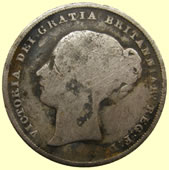 |
  |
||
| 1842 Victoria milled silver shilling | 1247 Henry III hammered silver voided half penny Rev /NDL/IDE - London mint |
||
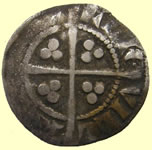 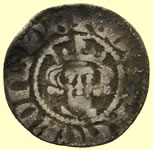 |
 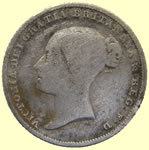 |
||
1279 Edward 1st hammered silver penny - Florin issue - Cross 3 Obv EDWR ANGL DNS HYB Rev VILL/A ***/ LLIE - Bristol mint |
1839 Victoria milled silver sixpence | ||
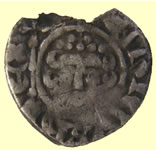  |
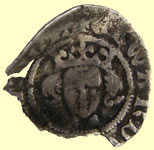  |
||
1208/9 John hammered silver short cross penny Class 6b1 Obv HENRICVS REX Rev BANDVLF ON LVND - Moneyer Randvlf of London mint |
1356-61 Edward III hammered silver penny - annulet in qtr on obv - Pre Treaty Durham ? Obv EDWARD ** Rev CIVI/TAS/LON/DON - London mint |
||
  |
  |
||
1586 Hans Krauwincel II Rose orb Jetton HANNS KRAVWINCKEL IN NVRENB |
1344 Edward III hammered silver penny - Florin issue - Cross 3 Obv EDWAR ANGL DNS HYB Rev CIVI/TAS/CAN/TOR - Canterbury mint |
||
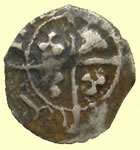 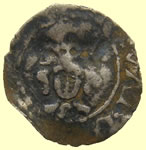 |
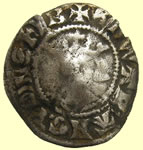 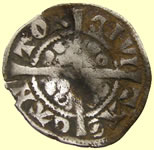 |
||
1361-9 Edward III hammered silver farthing - Type 17 Obv EDWARDVS ** London mint |
1344 Edward III hammered silver penny - Florin issue - Cross 3 Obv EDWAR ANGL DNS HYB Rev CIVI/TAS/CAN/TOR - Canterbury mint |
||
 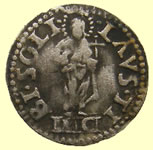 |
 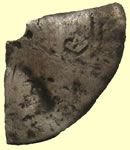 |
||
1501-1521). Rev: LAVS TIBI SOLI (Thee Alone be Praised). Haloed figure of Christ holding a cross. Obv: LE LAV DVX S M V (Leonardo Lauredan, Doge. St Mark of Venice.) Doge kneeling before Saint Mark. |
1/4 full medieval hammered silver groat | ||
1909 Edward VII milled gold half sovereign |
|||
 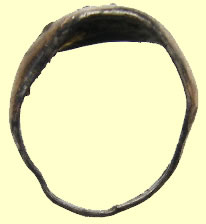 |
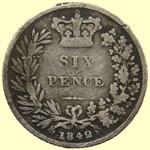 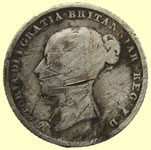 |
||
Victorian childs 9 carat gold ring with glass stones 14.18mm,0.45g Partial internal inscription legible - SHEER ** |
1842 Victoria milled silver sixpence | ||
1stC Roman fibular brooch 'The Langton Down style was developed in Gaul in the late 1st C BC but saw use in Britain from the time of the Claudian invasion until about 75 AD. The spring on these brooches is enclosed within a distinctive tubing of fairly thin construction.The bow is flat and very thin decorated with grooves and ribs (reeding)'
|
|||
  |
 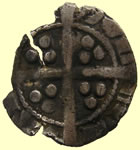 |
||
2ndC Roman fibular brooch Late 1st to 2nd century cast copper alloy headstud brooch |
1274 Edward 1st hammered silver penny Obv EDW ***** HYB Rev CIVI/TAS/LOND/DON - London mint |
||
 |
 |
  |
|
| 1500-1700 mount | 1500-1700 mount | Medieval mount | |
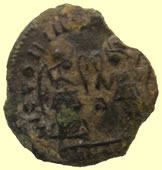 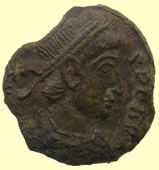 |
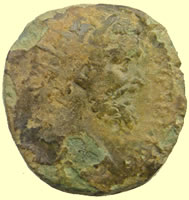 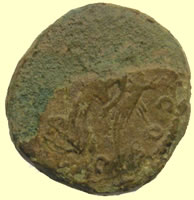 |
||
4thC Roman bronze sent for ID This one is one of the very last of the Constantinian-era Centenionales - with this 2 Victories holding wreaths reverse - VICTORIAE DD AVGG Q NN - and a similarly sized Vota - VOT / X / MVLT / XX - reverse for both Constantius II and Constans in 347-348 (this piece is for Constans) all exactly exactly the same except for the name on the obverse. I can't read the exergual mint mark on this one, but there is some very nice detail otherwise. Mark |
2ndC Roman bronze sent for ID This is actually a Dupondius rather than a Sestertius. Dupondii (2 Asses or 1/2 Sestertius) were struck in the same brass alloy as Sestertii but are a little smaller and portray the emperor wearing a radiate crown to distinguish bertween the Dupondius and the As with laureate busts on them. This is a posthumous commemorative for Marcus Aurelius - died in 180 - and although the reverse is fragmentary you can make out a little of the CONSECRATIO S - C legend and see the feathers of the eagle on the reverse. Obv: DIVVS ANTONINVS PIVS - confusing, but it was Aurelius' official name as the adopted son of the emperor Antoninus Pius Mark |
||
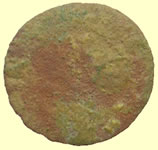  |
 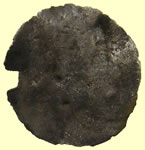 |
||
17thC Thomas Reynolds bay maker of Colchester hammered copper trade farthing |
Medieval long cross hammered silver penny - illegible | ||
  |
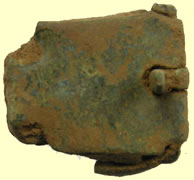 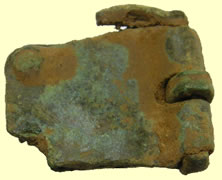 |
||
Medieval long cross hammered silver penny - illegible Rev CIVI/TAS/CAN/TOR - Canterbury mint |
Medieval buckle plate | ||
 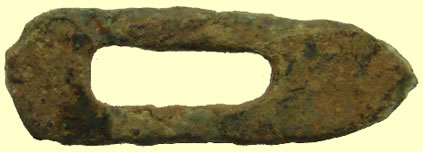 |
|||
| Roman bronze weaving shuttle | |||
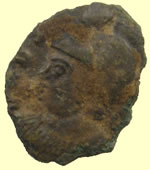 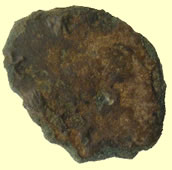 |
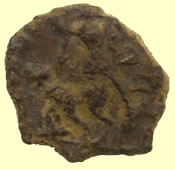 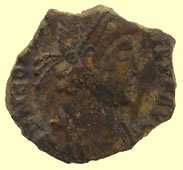 |
||
4thC Roman bronze sent for ID This is one of the city commemoratives of the period 330-340 - they were contemporary with the GLORIA EXERCITVS soldiers and standard(s) types. This one is the VRBS ROMA type in honor of Rome at the time of the adoption of Constantinople as Constantine's new capital. The anepigraphic reverse - which in your photo needs to be rotated about 45º clockwise - is the mythic shewolf suckling the twins Romulus & Remus, founders of Rome. Mark |
4thC Roman bronze sent for ID Clearly a reduced-module Majorina of Constantius II with the FEL TEMP REPARATIO reverse - soldier spearing fallen horseman - c. 350-360. Mark |
||
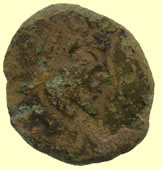 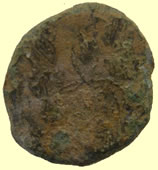 |
  |
||
4thC Roman bronze sent for ID I'm afraid I can't make any sense out of the reverse on the 1st piece in this email. The obverse obviously shows a somewhat "sharp-faced" male head to right - it's not possible to tell if there was a radiate crown intended or actually on the portrait at one time. The most important feature is that the portrait is bearded. Beards went out of style around the time Constantine became sole ruler of the Roman world, and with the exception of only a few folks - Julian II being the most commonly-seen of them - including Johannes and Eugenius (both very rare) - you virtually don't see beards on Imperial portraits again. This portrait looks nothing at all like Julian, so I'm pretty sure it's not him, or any of Illyrian Emperors from Aurelian through Diocletian - the face is simply the wrong shape. I suspect it's either Claudius Gothicus (268-270) or one of the Gallic emperors - or a contemporary copy of one or the other. The only thing I can even guess the reverse might be is a very minimalist attempt to depict the standing eagle on a Gothicus "CONSECRATIO" posthumous antoninianus - a very commonly copied type. There is also a possibility it might be Gothicus' brother Quintillus who succeeded him for a very brief period - 2 or 3 months in 270 - records from the time are spotty and undependable, some say his reign was as short as 17 days, but the relative commonness of his coins tends to make that short of a reign pretty questionable. If it is Quintillus, I have no idea what the reverse is supposed to be So those are my best guesses - not, ultimately, satisfactory - but I'll keep thinking about it and perhaps it will become clearer what that reverse is supposed to be. Mark |
1327-77 Edward III hammered silver farthing - Star marked coinage, star after DON Obv + EDWARDVS REX AN Rev CIVI/TAS/LON/DON* - London mint |
||
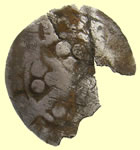 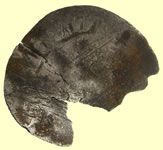 |
  |
||
| Medieval hammered silver penny - illegible | Roman lead medallion | ||
  |
|||
1762 George III 1/4 gold guinea - 15.63mm,2.08g Love token |
|||
|
|||
Stunning large gilded silver medieval decorated silver finger ring - reported as treasure to museum 7.26g, 23.59mm |
|||
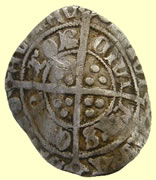 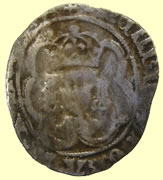 |
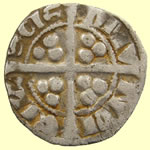 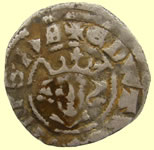 |
||
1504- 7 Henry VII hammered silver half groat - Two arches unjewelled - Crosslet im Obv HENRICUS DEI GRA REX ANGLIE Rev CIVI/TAS/CAN/TOR - Canterbury mint |
1307 Edward II hammered silver penny - Class 15b Obv EDWAR ANGL DNS HYB Rev VILL/SCIE/DMV/NDIBury St Edmunds mint |
||
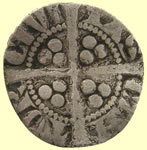 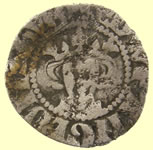 |
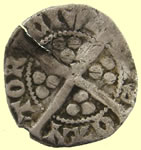 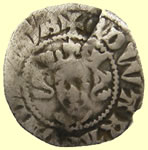 |
||
1327 Edward III hammered silver penny Obv EDWR ANGL DNS HYB Rev CIVI/TAS/CAN/TOR - Canterbury mint |
1344 Edward III hammered silver Florin penny - Cross 3 Obv EDWAR ANGL DNS HYB Rev CIVI/TAS/CAN/TOR - Canterbury mint |
||
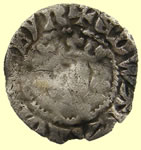  |
  |
||
1344 Edward III hammered silver Florin penny - Cross 3 Obv EDWAR ANGL DNS HYB Rev CIVI/TAS/LOND/DON - London mint |
Medieval enamelled harness pendant - blue and red enamel remains | ||
 |
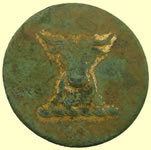 |
 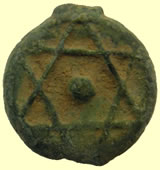 |
|
| Victorian copper ring | 19thC livery button | Medieval copper bale seal | |
 |
  |
||
| 1500-1700 mount | 1696 William III milled silver shilling - Coventry mint | ||
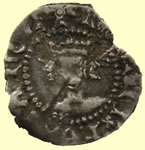 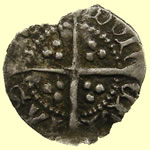 |
  |
||
1413 -1422 Henry V hammered silver half penny - broken annulet by crown - im pierced Std G type Rev CIVI/TAS/LOND/DON - London mint |
1697 William III milled silver sixpence - Norwich mint | ||
 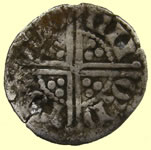 |
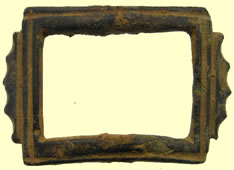 |
||
1247 Henry III hammered silver voided long cross penny - Class 3b Ov HENRICVS REX III Rev TOM/ASO/ONN/ORb - Moneyer Tomas of Northampton mint |
Georgian shoe bucckle | ||
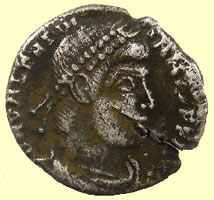  |
|||
Very crisp 4thC Roman silver sent for ID Wow, very nice. This is, of course, a Siliqua of Valentinian, I 364-375. From the mint at Arles, it dates to the earlier part of his reign, 364-7. The reverse type is RESTITVTOR REIP - (Restorer of the Republic - pure propaganda) and shows the emperor standing facing, head right, holding a labarum with Chi-Rho symbol and Victory on globe. The OF - II in the field indicates the 2nd offiicina or workshop of the mint, the star above the II is a sequence mark.
Mark |
|||
 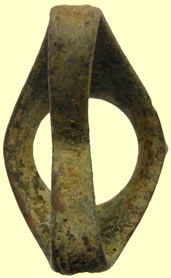  |
|||
| 17thC decorated copper ring | |||
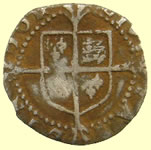 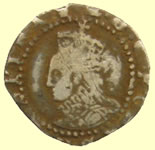 |
  |
||
| 1590-2 Elizabeth 1st hammered silver penny | 1844 Victoria milled silver sixpence | ||
  |
 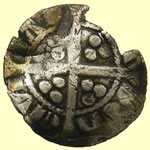 |
||
1247 Henry III hammered silver voided long cross half penny Moneyer Nicole |
1327 Edward III hammered silver penny Obv EDW** ANGL DNS HYB Rev CIVI/TAS/LOND/DON - London mint |
||
  |
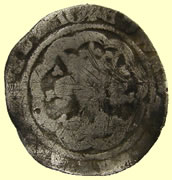 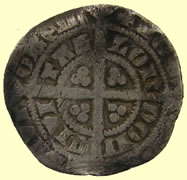 |
||
| C8thC Saxon mount with circle design | 1353-1355 Edward III hammered silver half groat - Cross 3, 9 arches to treasure, Trefoils on cusps unbarred N's - Series 3 Rev CIVI/TAS/LOND/DON - London mint |
||
 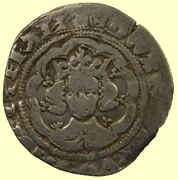 |
  |
||
1351 Edward III hammered silver half groat - Pre treaty series B - 9 arches to treasure, Trefoils on cusps - open E & C's Obv EDWARDVS REX ANGLI Z FRAN Rev CIVI/TAS/LOND/DON - London mint |
1634 Charles 1st hammered copper rose farthing | ||
  |
  |
||
1586 Hans Krauwincel II Rose orb Jeton HANNS KRAVWINCKEL IN NVRENB |
Medieval mount | ||
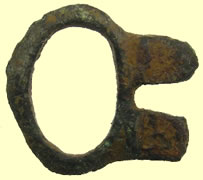 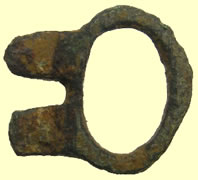 |
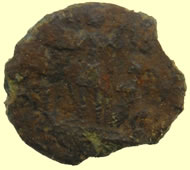  |
||
| Medieval buckle | 4thC Roman bronze sent for ID | ||
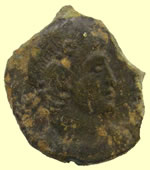  |
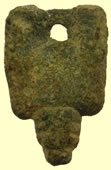 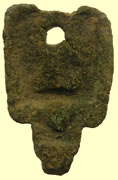 |
||
4thC Roman bronze sent for ID Either Valentinian I or Valens, the GLORIA ROMANORVM reverse with the emperor walking to the right, dragging a captive and carrying a labarum Mark |
Medieval hooked fastener | ||
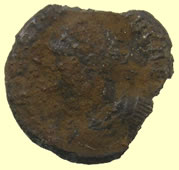  |
  |
||
4thC Roman bronze sent for ID I can't be really specific, but it is one of the Caesars during the time of Constantine - it might be (but is unlikely to be) Licinius II, or it could be any of the 4 sons of Constantine the Great - Crispus, Constantine Jr., Constans or Constantius II. This probably dates to the late 3-teens / early 320's. This legend, wreath and Vota combination reverse type was struck for all 5 of the Caesars (as well as 2 similar types for the Augusti) at various times. The legend on the obverse ends "...CAES" so we know it's one of the Caesars, but I don't think we'll ever be able to tell which one. We also know it's not either of the "Augustus" legend, wreath & Vota reverse types (one honors Constantine, one honors Licinius). For a Caesar, the circumferential legend on the reverse is CAESARVM NOSTRORVM ( [to] Our Caesars) - the Vota within the wreath is VOT / X - in other words, it's someone's 1st decennalia - the ceremonial observation of the completion of vows made to do certain things and make certain sacrifices for the 1st 10 years of rule, in order to assure the success of the next 10 (or 5) years. I can't say whose it is - it would take more than just a complete obverse legend identifying the person on the obverse to be certain whose decenallia is being cited. The decennalia named is not necessarily for the person on the obverse of the coin which complicates the matter just a little so it would probably take a complete mint mark (and any symbols associated with the mint mark) to be sure of the date and threfore whose decenallia is being honored. Oh, right, one other thing - the photo you sent of the reverse is 180º upside-down. Mark |
1553 Mary hammered silver groat - Pomegranate mint mark | ||
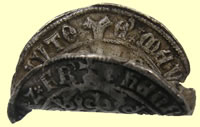 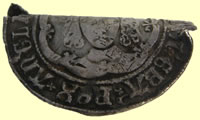 |
|
||
1504- 7 Henry VII hammered silver groat - two arches unjewelled to crown, Crosslet im Obv hENRIC DI GRA REX ANGLIE Z FR Rev CIVI/TAS/LOND/DON - London mint |
18thC Georgian silver hanger - Lion mark, maker TL Thomas Liddiard of London 1778..1787 |
||
 |
 |
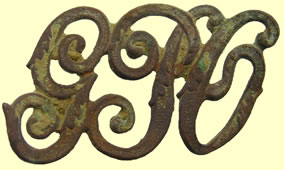 |
|
| 17thC button | Medieval D buckle | General Post Office badge | |
  |
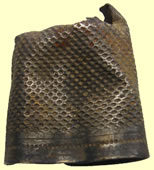 |
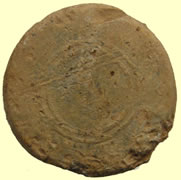 |
|
| 16thC Tudor button | Georgian silver thimble | Posat medieval lead trade weight | |
Crispy Roman silver is start to 'cook' up after being in the cooker since March 2012 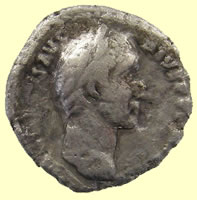 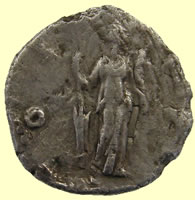 |
|||
Cooked Roman silver sent for ID This one came out quite clear. It's Antoninus Pius (138-161) and the reverse type is FORTVNA AVG - which would be easy to tell even if the legend did not have the few clear letters with telltale wide spacing like this one displays. The rudder and cornucopiae attributes are almost exclusively the adjuncts of Fortuna. This coin was meant to be dated by the obverse legend, but the portion stating the Tribunician year is mostly off flan making it illegible. However, this type was issued only in his 23rd & 324th Tribunician year, so we can date it to near the end of his reign 159-161. Mark |
|||
 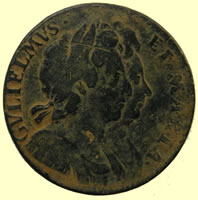 |
|||
Best condition William and Mary copper I have ever seen dug 1694 William and Mary milled copper half penny |
|||
 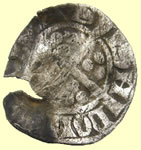 |
 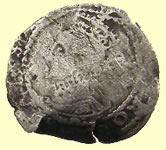 |
||
1327 Edward III hammered silver penny - Cross 1 Obv EDW** ANGL DNS HYB Rev CIVI/TAS/LOND/DON - London mint |
1574 Elizabeth 1st hammered silver penny | ||
  |
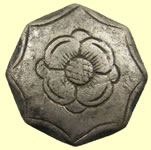 |
||
| 1817 George III milled silver sixpence | 18thC Royal Navy button | ||
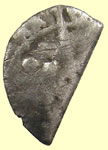 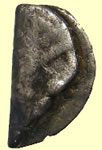 |
 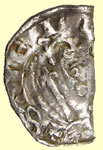 |
||
| Medieval hammered silver penny - quatrefoil to centre of reverse cross- York mint | 1150 Stephen hammered silver penny - this appears to be a mule from North 879 and 878 Obv + STIEFNE Rev Cross fleurty with a pile surrounded by a trefoil of annulets in each angle Possible Bury St Edmunds mint - GILBERT Ref North 879 18.58mm, 1.38g Sent for recording and confirmed ID |
||
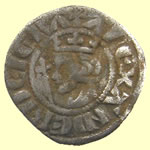 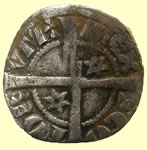 |
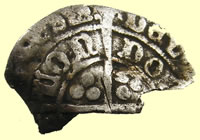 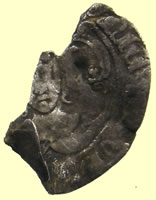 |
||
1280 - 1286 Scottish Alexander III hammered silver half penny - 2nd coinage Obv + ALEXANDER DEI GRA Rev REX SCOTORUM Long cross, a star in two quarters, each star has 6 points - type SA3HD -010 14.05mm0.58g |
Medieval Henry hammered silver groat Rev CIVI/TAS/LOND/DON - London mint |
||
 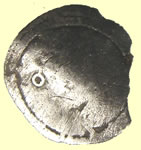 |
|
||
1351 Edward III hammered silver penny - Pre Treaty Durham Obv annulets to both side of neck Rev annulet in one quadrants |
Georgian gilded ring with stone | ||
 |
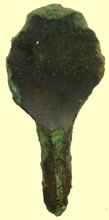 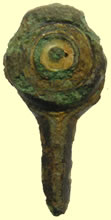 |
||
| 1500-1700 hinge plate | 2ndC Roman plate brooch - white central enamelled section remains | ||
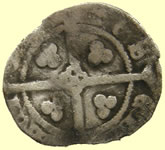  |
 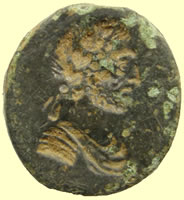 |
||
1356 - 61 Edward III hammered silver penny - Pre Treaty series G - (a) annulet stops Quadrefoil and pellet in centre of reverse cross - Archiepiscopal issue Obv EDWARDVS REX ANGLI Rev CIVI/TAS/EBO/RACI - York mint
|
Georgian double sided seal matrix | ||
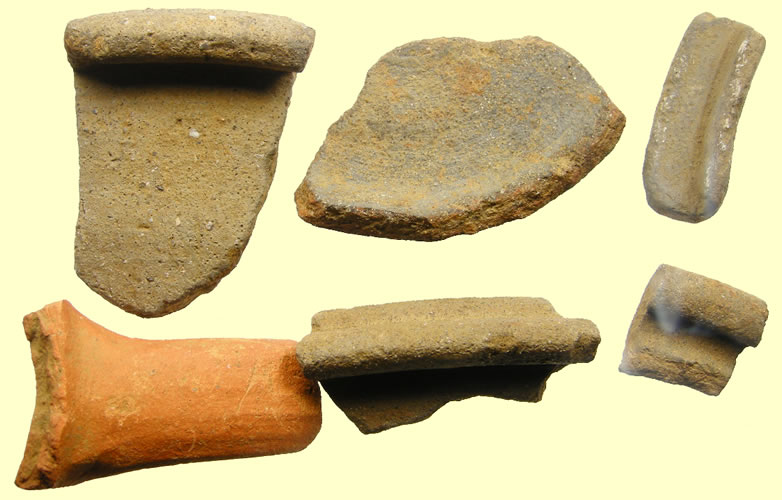 |
|||
| Roman pottery | |||
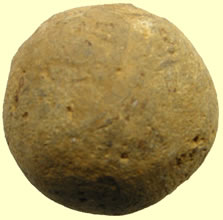 |
 |
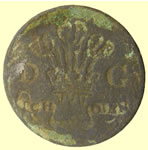 |
|
| 16thC stone cannon ball | George V Royal Engineers button | 3rd Dragoons Guards one piece button- unlisted type |
|
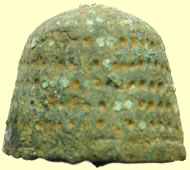 |
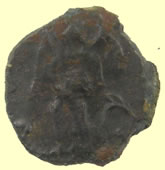 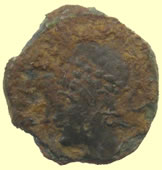 |
||
| Medieval beehive thimble | 4thC Roman bronze sent for ID This type is one which belongs to a smallish group of reverse devices which elicit "Ya know, that looks like..." comments on a regular basis. Quite often these are Victory reverses since the pagan deity Victory formed the visual template for the Western visual concept of an "Angel". The Victory figures so common in Roman decorative arts simply morphed directly into Christian angels as the Empire shifted from a pagan to a Christian orientation. This particular coin has also elicited a few other comments - with certain exergual mintmarks which can look somewhat like "wheels" we have had students insist that they see "An angel on a skateboard...". |
||
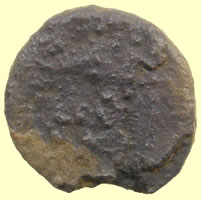 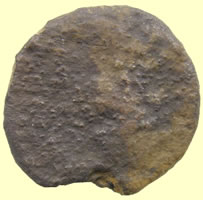 |
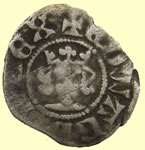  |
||
| BC Roman Republican silver coin - cooking to remove crust | 1344-51 Edward III hammered silver half penny - Florin coinage - Type 7 Obv +EDWARDVS REX Rev CIVI/TAS/LOND/DON - London mint 15.17mm, 0.62g |
||
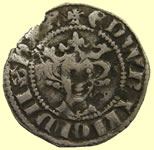 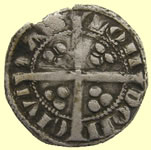 |
  |
||
1272 Edward Ist hammered silver penny - Type 9a - Star on breast - un barred N's - pellet eyes Obv +EDWR ANGL DNS HYB Rev CIVI/TAS/LOND/DON - London mint |
1935 George V milled silver half crown {30 pence) | ||
  |
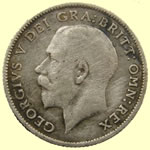  |
||
| 1844 Victoria milled silver shilling {12 pence} | 1913 George V milled silver sixpence | ||
Size comparison from milled silver 3 pence, sixpence, shilling (12 pence) to half crown (30 pence) |
|||
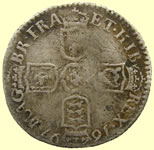 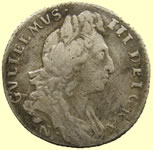 |
 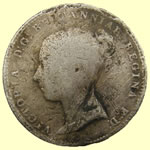 |
||
| 1697 William III milled silver sixpence - Norwich mint | 1868 Victoria milled silver 3 pence | ||
   |
|||
| Unknown early widget - looks like a fibular brooch but no signs of any fixings ?? One for the museum | |||
 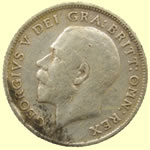 |
  |
||
| 1919 George V milled silver sixpence | 1578 Elizabeth 1st hammered silver half groat | ||
 |
 |
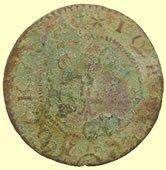  |
|
| Georgian watch winder | Medieval buckle | 1670 John Winnock of Colchester hammered copper trade half penny Obv HIS HALF PENY Rev IOHN WINNOCK Fleur de Lis |
|
  |
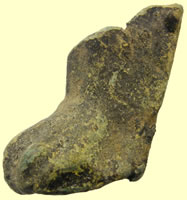 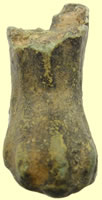 |
||
| 1594-6 Elizabeth 1st hammered silver penny | Medieval bronze pot foot | ||
 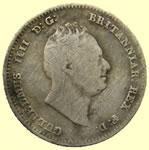 |
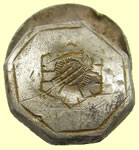 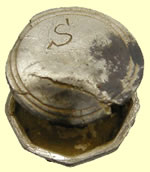 |
||
| 1836 William IV milled silver four pence | 18thC Royal Navy initialled silver cuff links | ||
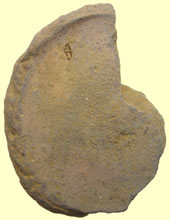 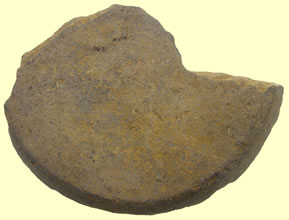 |
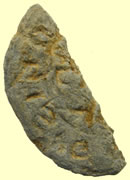 |
 |
|
| 6inch dia Roman pottery bowl bottom | 13thC lead seal matrix | 17thC copper thimble | |
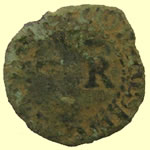 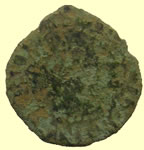 |
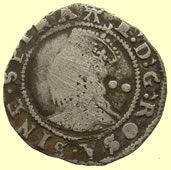  |
||
17thC Thomas Reynolds bays maker of Colchester hammered copper farthing - undated type |
1582-4 Elizabeth 1st hammered silver half groat | ||
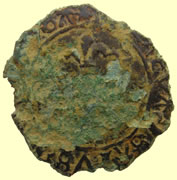  |
 |
||
Crown introduced in 1340 by Philip VI (1328-50) Royal Crown with 3 rosettes across body of crown Rev Triple banded straight cross fleuretty AV
|
17thC crotal bells | ||
  |
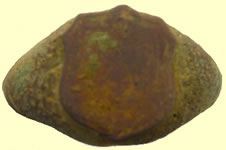 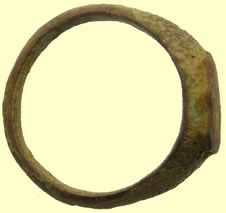 |
||
| 1816 George III milled silver sixpence | Edwardian copper signet ring | ||
 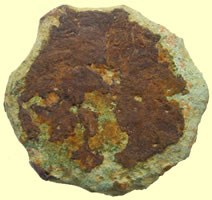 |
 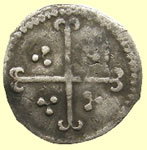 |
||
| 138AD Hadrian Roman bronze coin | 1590-2 Elizabeth 1st hammered silver half penny – hand mintmark
|
||
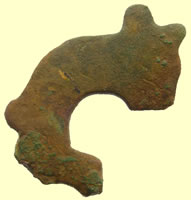 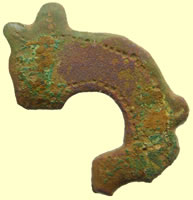 |
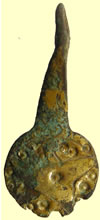  |
||
Late Early Medieval (Anglo-Scandinavian) cast copper alloy fragment of a cheek piece from a harness fitting. |
Saxon gilded harness pendant - circle and star design | ||
As dug and now 'cooking' to remove crust
Primary Saxon silver sceat 600- 700 AD - sent to Fitzwilliam museum for recording and ID Left facing bust 1.23g, 11.41mm This new find (EMC 2013.0069) might be Series R9, but enhanced images would certainly be appreciated. Best wishes, Martin Thank you for these excellent images of your coin. I can now see that it is interesting late variant of the Series E Vernus type, group 3, and so a coin of the Primary phase. c.695-720, and probably from East Anglia.
|
|||
 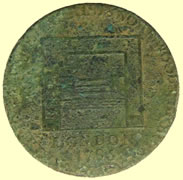 |
  |
||
1795 Washington Grate Halfpenny Obverse: G. WASHINGTON. THE FIRM FRIEND TO PEACE & HUMANITY [cinquefoil] |
1150 AD Stephen hammered silver farthing
|
||
Huge medieval purse bar with W inscription - this would have been 7 inches long when complete ?
Towards the end of the 1400s it became fashionable for rich men to wear large purses hanging from their belts. They were made of velvet or other expensive fabric fitted to fancy metal frames. They were generally sewn below the bar. |
|||
  |
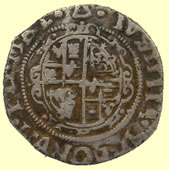 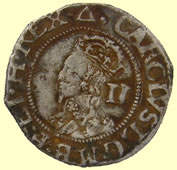 |
||
1344 Edward III hammered silver penny - Florin issue Cross 3 Obv EDWAR ANGLE DNS HYB Rev CIVI/TAS/LON/DON |
1639-40 Charles 1st hammered silver half groat - Triangle mint mark | ||
 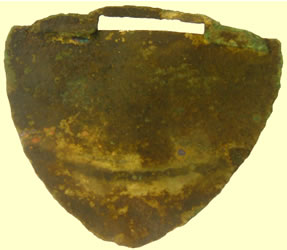 |
|||
| I just cleaned up this crusty widget and it is decorated and gilded and reminds me of the bottom part cheek piece off a helmet - going to let the museum have a look | |||
Medieval silver continental Sterling of Edward silver penny - Gaucher of Chatillon, count of Porcien, at Yves mint 1313-22. Obv +GALCh’SCOMESPORC Rev MON/ETN/OVA/y’VE |
|||
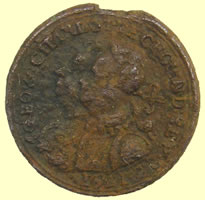  |
|||
| 1761 George III & Charlotte coronation medallion | |||
  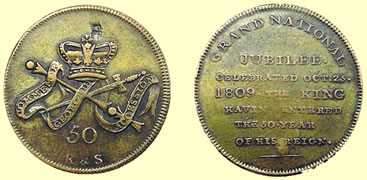 |
|||
George III - Jubilee of his reign (Crown, sword & sceptre) - 1809
Side 1: COMMEMOR GEORGE III ACCESSION on the ribbon. Below, 50 and K & S Side 2: GRAND NATIONAL / JUBILEE . / CELEBRATED OCT . 25 . / 1809 . THE KING / HAVING ENTERED / THE 50. YEAR / OF HIS REIGN.
|
|||
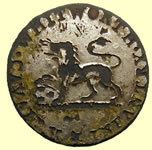 |
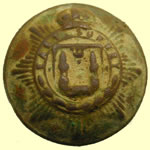 |
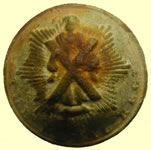 |
|
Whitworth Cavalry & Infantry ? No regiment or militia listed ? |
East Surrey Regiment The East Surrey Regiment was a regiment in the British Army formed in 1881 from the amalgamation of the 31st (Huntingdonshire) Regiment of Foot and the 70th (Surrey) Regiment of Foot. In 1959, it was amalgamated with the Queen's Royal Regiment (West Surrey) to form the Queen's Royal Surrey Regiment. |
19thC The Royal Regiment of Scotland button | |
 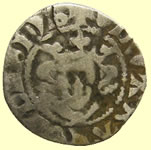 |
 |
||
1344 Edward III hammered silver penny - Florin issue Cross 3 Obv EDWAR ANGLE DNS HYB Rev CIVI/TAS/LON/DON |
British Military belt buckle DIEU . ET. LIO |
||
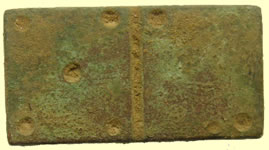 |
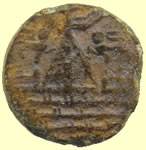  |
||
| Georgian domino | 15th/16thC British Gold Nobel coin weight - Ship type with lis and Lion - Fleur de Lis on the stern |
||
  |
 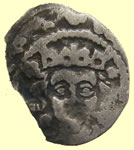 |
||
1641-3 Charles 1st hammered silver penny - mintmark 2 dots |
Irish 1478 - 1483 Edward IV hammered silver penny - Seventh (Sun & Roses) Coinage Rose each side of neck - Long cross with rose at centre, a rose and two suns or a sun and two roses alternating in the angles Obv EDWARD REX ANGL Z FRANC Rev CIVI/TAS/DUB/LIM - Dublin mint |
||
Fixed hammered gold 1351-1361 Edward III gold half noble - Closed E at centre of cross - satire stops - Pre Treaty Period The obverse shows a forward facing king in ship with sword in right hand and quartered shield of England and France in left. Obv EDWAR DEI REX ANGL Z FRA D 4.12g, 25.12mm |
|||
Fixed hammered gold 1361 Edward III hammered gold 1/4 noble Obv + EDWR + R ++ ANGLIE DVNS HY Edward III (1361), Quarter-Noble, Transitional Treaty Period, quartered shield of arms, two pellets in upper left quarter, within beaded and linear tressures of eight arcs, pellets on cusps, fleur trefoils in spandrels, all within beaded circle, comma and saltire stops in legend, +edwr;r; anglie: dnvs; hv rev ornamental cross potent with annulets in angles and at centre, lis terminals, lions in angles, lis above lion in fourth quarter, within beaded and linear tressures of eight arcs, trefoils in spandrels, beaded circle surrounding, saltire stops in legend, +exaltabitvr: in: gloria 18.99mm, 1.93g |
|||
Size comprison between half and qtr gold Noble |
|||
 |
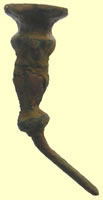 |
 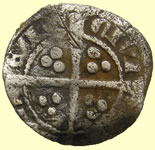 |
|
| 1250 - 1400 Medieval buckle | 16thC Tudor seal spoon handle | 1272 Edward 1st hammered silver penny Obv EDWR ANGLE DNS HYB Rev CIVI/TAS/DVR/ENE - Durham mint |
|
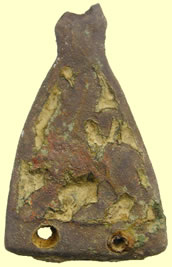 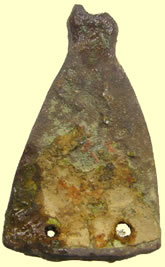 |
|||
Late Saxon c10thC stirrup strap mount Class A Type 11a late Early Medieval (Anglo-Saxon) cast copper alloy stirrup strap mount of Williams class A type 11. The main body of the mount is triangular, with the two side edges being slightly convex. There is a trefoil terminal at the apex of the mount containing a rivet hole; the hole is slightly off centre, probably due to wear on the right hand side of the terminal. The main body of the mount has a cast design of a left facing lion (sometimes interpreted as a wolf), looking upwards with one front paw raised and a tail curled over its back. Below this design is an undecorated area containing a further two circular rivet holes, one of which is filled with corrosion products. There is a short flange projecting at a right angle from the lower edge of the mount, running between the positions of the lower rivet holes.The reverse of the mount is plain and undecorated.
Class: Strap Mount ChronologyBroad period: EARLY MEDIEVAL Dimensions and weightLength: 47.56 mm
|
|||
 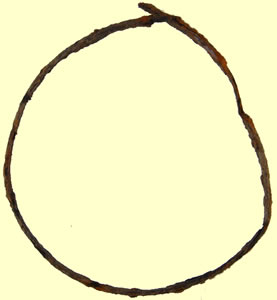 |
|||
| Possible gilded Iron Age bracelet | |||
  |
  |
||
| 17thC thimble with name inscription | C 10thC Saxon lead gaming piece | ||
 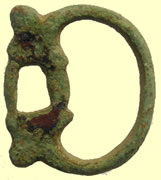 |
|
||
| Roman fixed buckle for suspension | Roman barrel pad lock lock arm |
||
 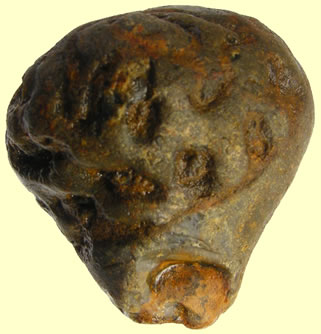 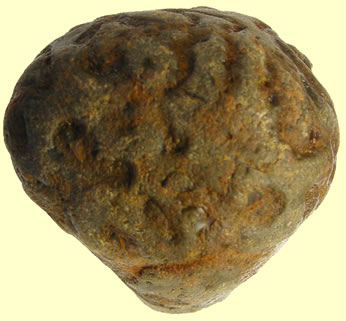 |
|||
Interesting large carved stone - one for the museum to look at 63.26mm W x 63.93mm H |
|||
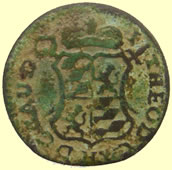 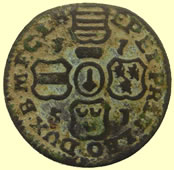 |
  |
||
1751 Joan Theodor of Bavaria (1744-1763) 2 liard Cu Obv EP ET PR LEO DUX B M F Ñ L H 1751 |
2ndC Roman silver coin - cooking it to remove crust | ||
  |
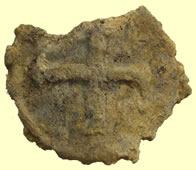 |
||
| 2ndC Roman fibular brooch | Medieval lead Knights Templer badge | ||
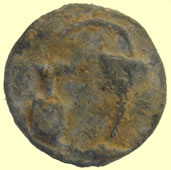 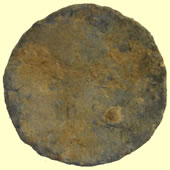 |
  |
||
| 16th C Elizabeth 1st prohibited lead tavern pieces - bottle flowing into glass | 13thC non heraldic lead seal matrix | ||
 |
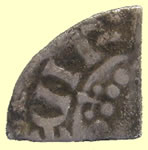 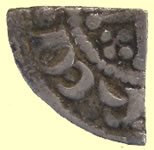 |
||
| 1250- 1400 buckle | 1180-1189 Henry 1st hammered silver short cross farthing – Class - Obv RE(I |
||
  |
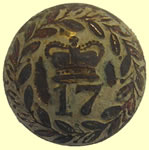 |
||
| Medieval lead token | 17th (Leicestershire) Regiment of Foot button | ||
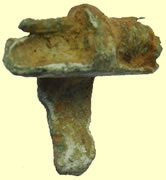 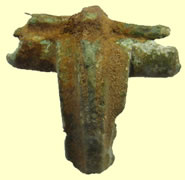 |
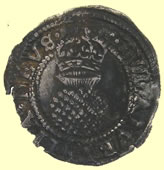 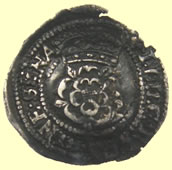 |
||
| 2ndC Roman fibular brooch | 1623-4 James 1st hammered silver half groat – Lis mint mark |
||
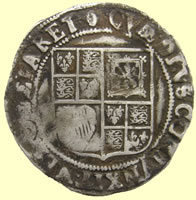  |
|||
| 1605-6 James 1st hammered silver shilling (12 pence) - Rose mint mark | |||
  |
|||
| Anglo Saxon harness cheek piece | |||
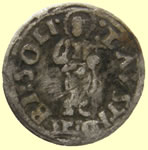 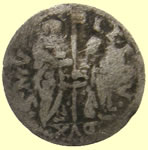 |
 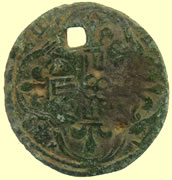 |
||
(1501-1521). Rev: LAVS TIBI SOLI (Thee Alone be Praised). Haloed figure of Christ holding a cross. Obv: LE LAV DVX S M V (Leonardo Lauredan, Doge. St Mark of Venice.) Doge kneeling before Saint Mark. |
1350-64 Field of France Jetton Obv Field bearing 9 lis arranged 1-2-3-2-1 with some tracery: + LED CONTE rosette TROVVERES |
||
As dug and now 'cooking' to remove crust Primary Saxon silver sceat 600- 700 AD - sent to Fitzwilliam museum for recording and ID Left facing bust 1.23g, 11.41mm This new find (EMC 2013.0069) might be Series R9, but enhanced images would certainly be appreciated. Best wishes, Martin Saxon silver sceat - Series E Vernus type, group 3, and so a coin of the Primary phase. c.695-720 EMC 2013.0069 |
|||
As dug and now 'cooking' to remove crust Primary Saxon silver sceat 600- 700 AD - sent to Fitzwilliam museum for recording and ID Left facing bust 1.23g, 11.41mm Many thanks. This is EMC 2013.0066. Series D (Type 2c). Best wishes, Martin |
|||
Previous 2013 Feb finds click here
|
|||
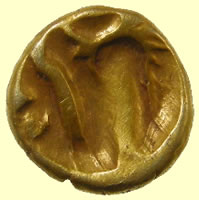
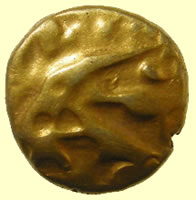
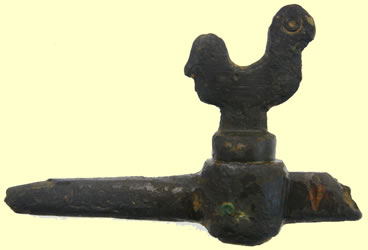
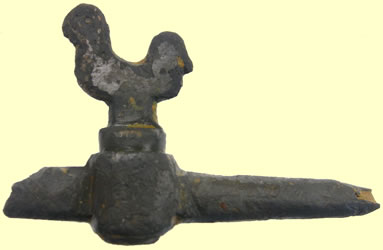

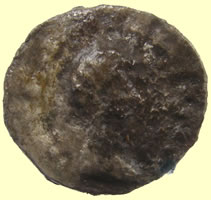
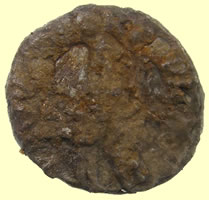
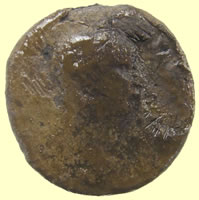
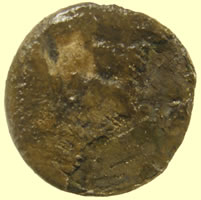

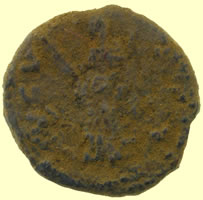
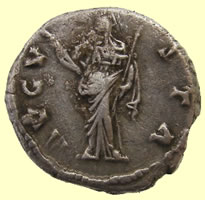
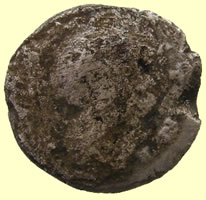
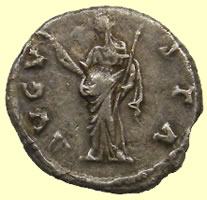
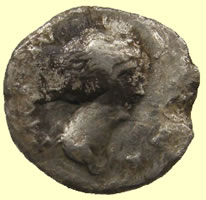
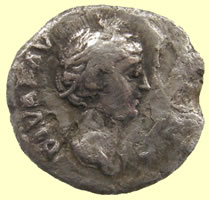
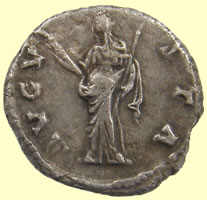


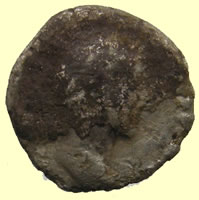
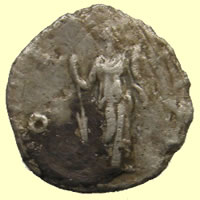
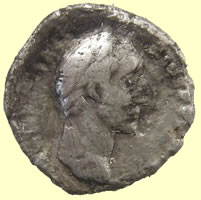
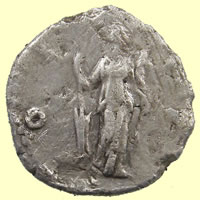


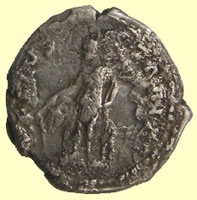
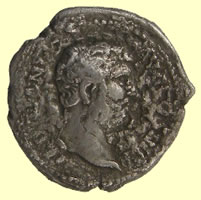
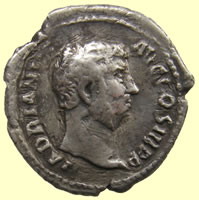
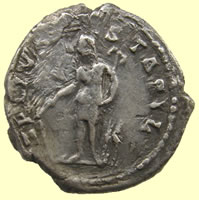

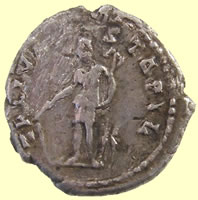
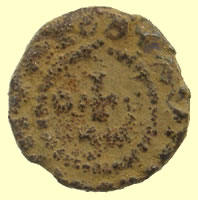
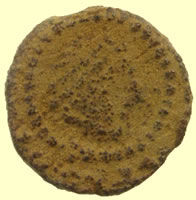
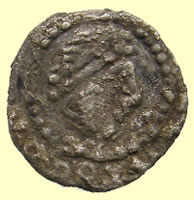
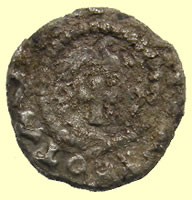


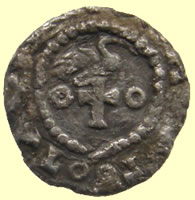
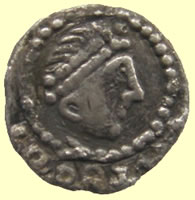

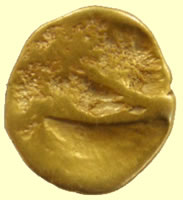

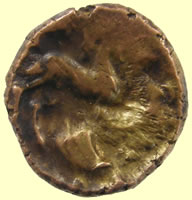
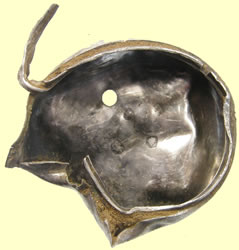
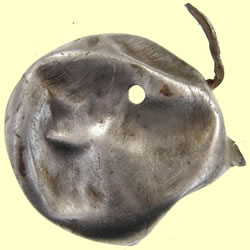

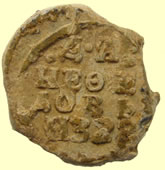

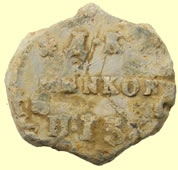
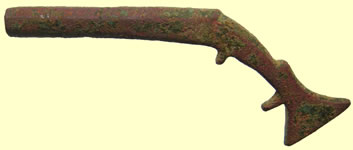
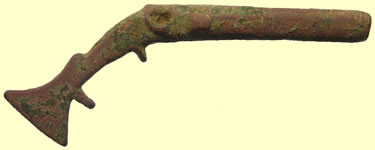


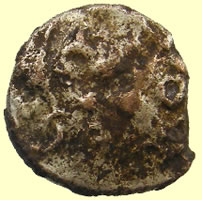
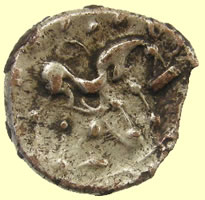

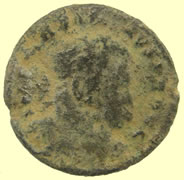




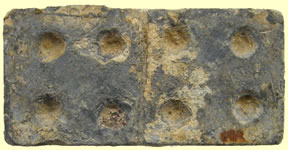
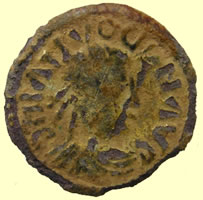
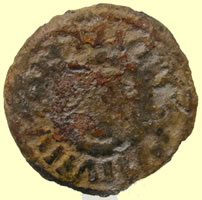

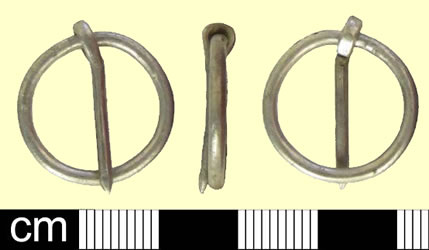
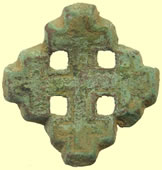
 'A badge for a Knight of the Order of the Holy Sepulchre in bronze and dating somewhere around C13/14th possibly very slightly later . This is a very scarce item and it relates to The Equestrian Order of the Holy Sepulchre of Jerusalem being a Catholic chivalric order of Knighthood that traces its roots to Godfrey of Bouillon, principal leader of the First Crusade. According to reliable sources in the Vatican and Jerusalem, it began in historical reality as a mixed clerical and lay confraternity (association) of pilgrims which gradually grew around the most central of the Christian holy places in the Middle East, the Holy Sepulchre or the tomb of Jesus Christ.This would have been a pin for a member of the order , there is a mark on the reverse where the original pin would have been fixed '
'A badge for a Knight of the Order of the Holy Sepulchre in bronze and dating somewhere around C13/14th possibly very slightly later . This is a very scarce item and it relates to The Equestrian Order of the Holy Sepulchre of Jerusalem being a Catholic chivalric order of Knighthood that traces its roots to Godfrey of Bouillon, principal leader of the First Crusade. According to reliable sources in the Vatican and Jerusalem, it began in historical reality as a mixed clerical and lay confraternity (association) of pilgrims which gradually grew around the most central of the Christian holy places in the Middle East, the Holy Sepulchre or the tomb of Jesus Christ.This would have been a pin for a member of the order , there is a mark on the reverse where the original pin would have been fixed '


